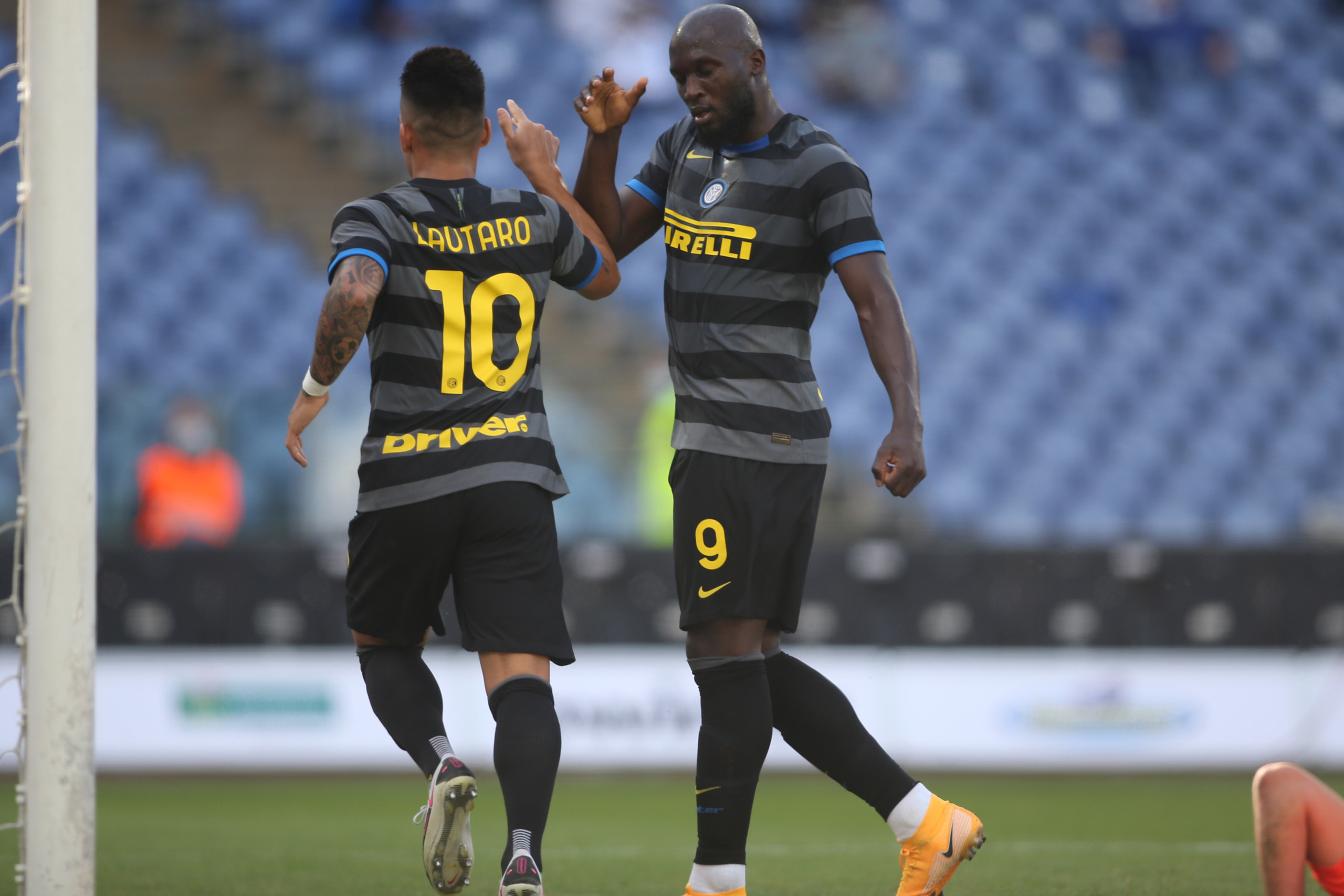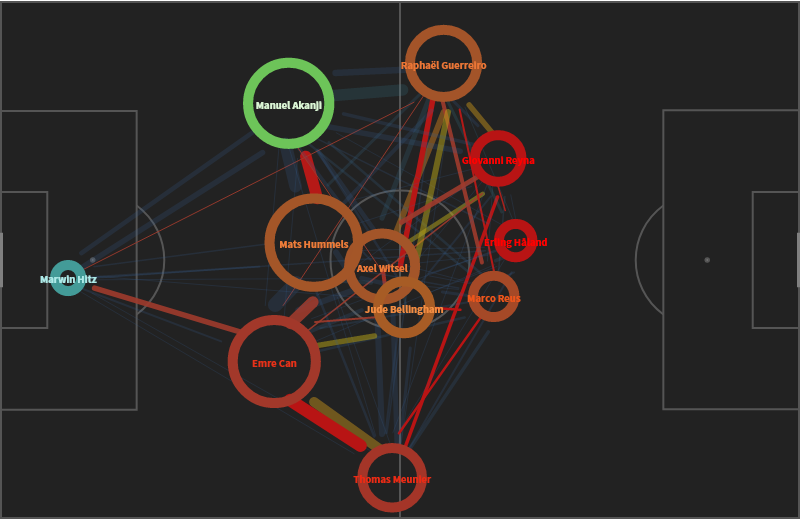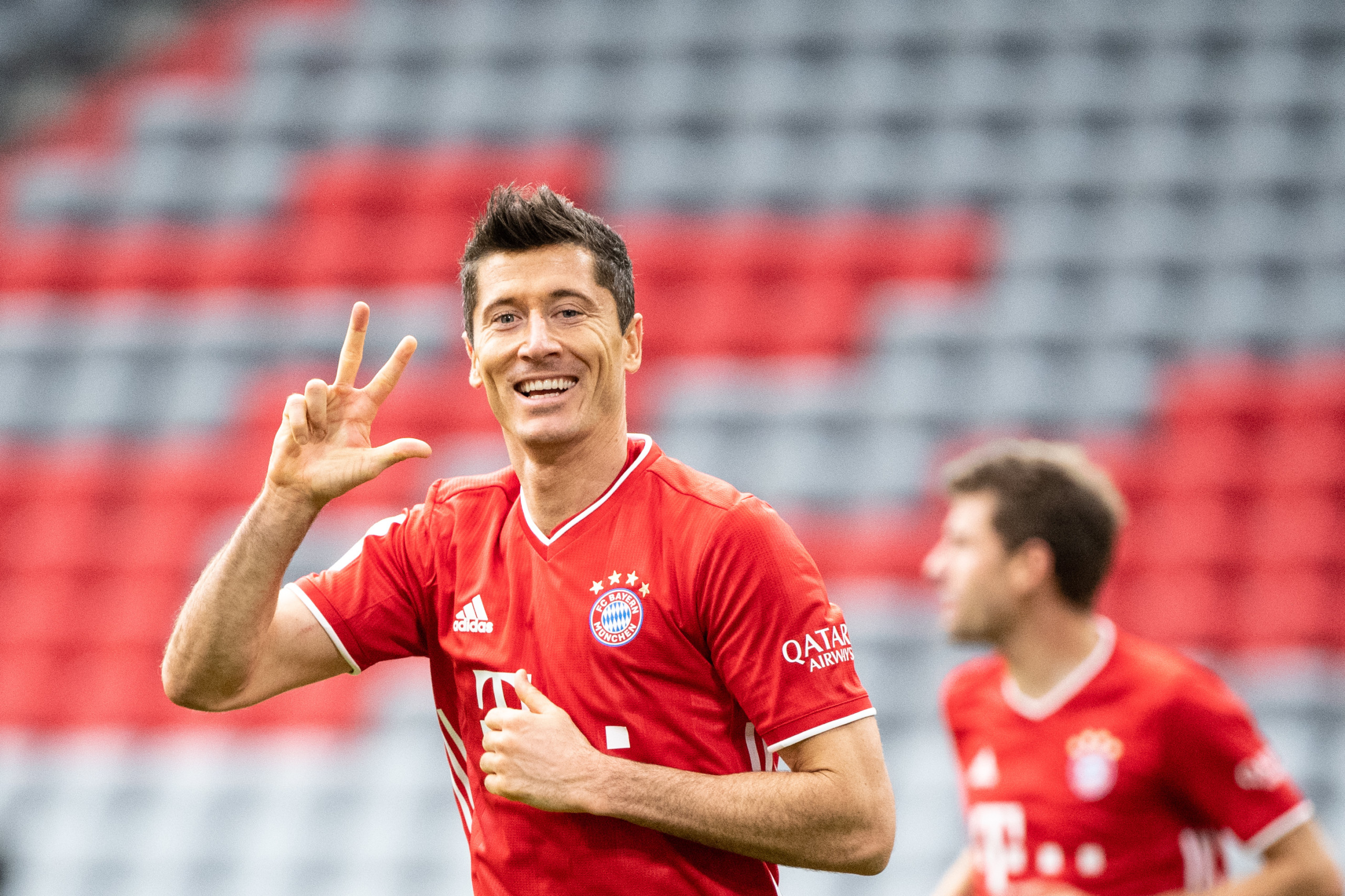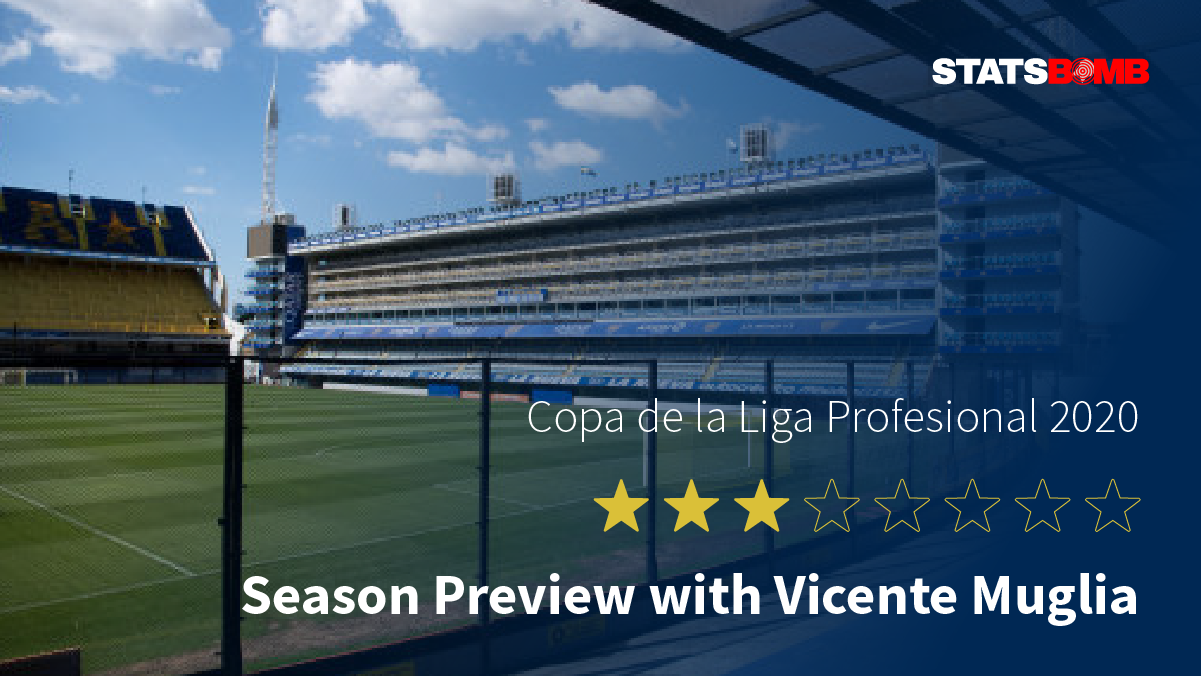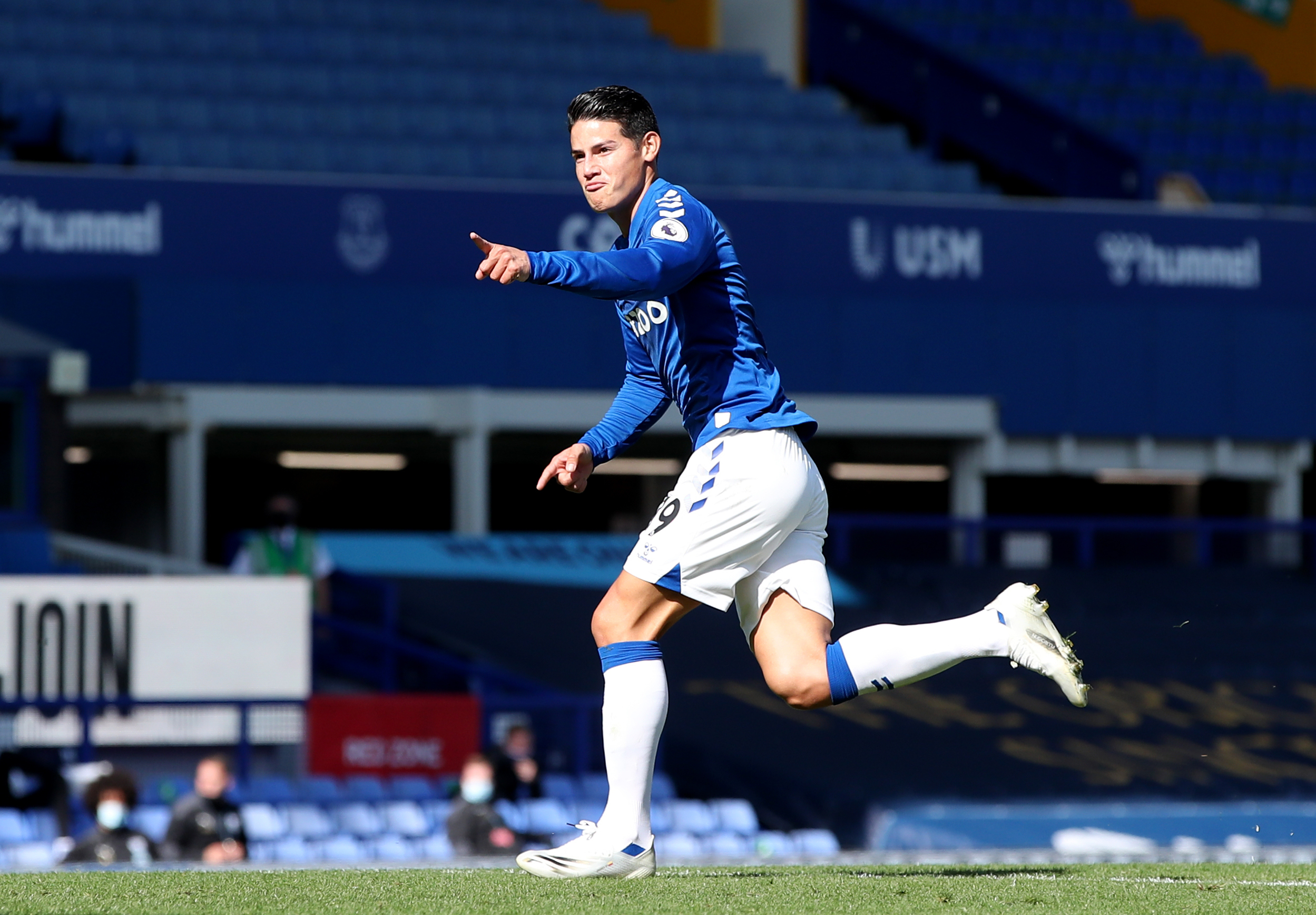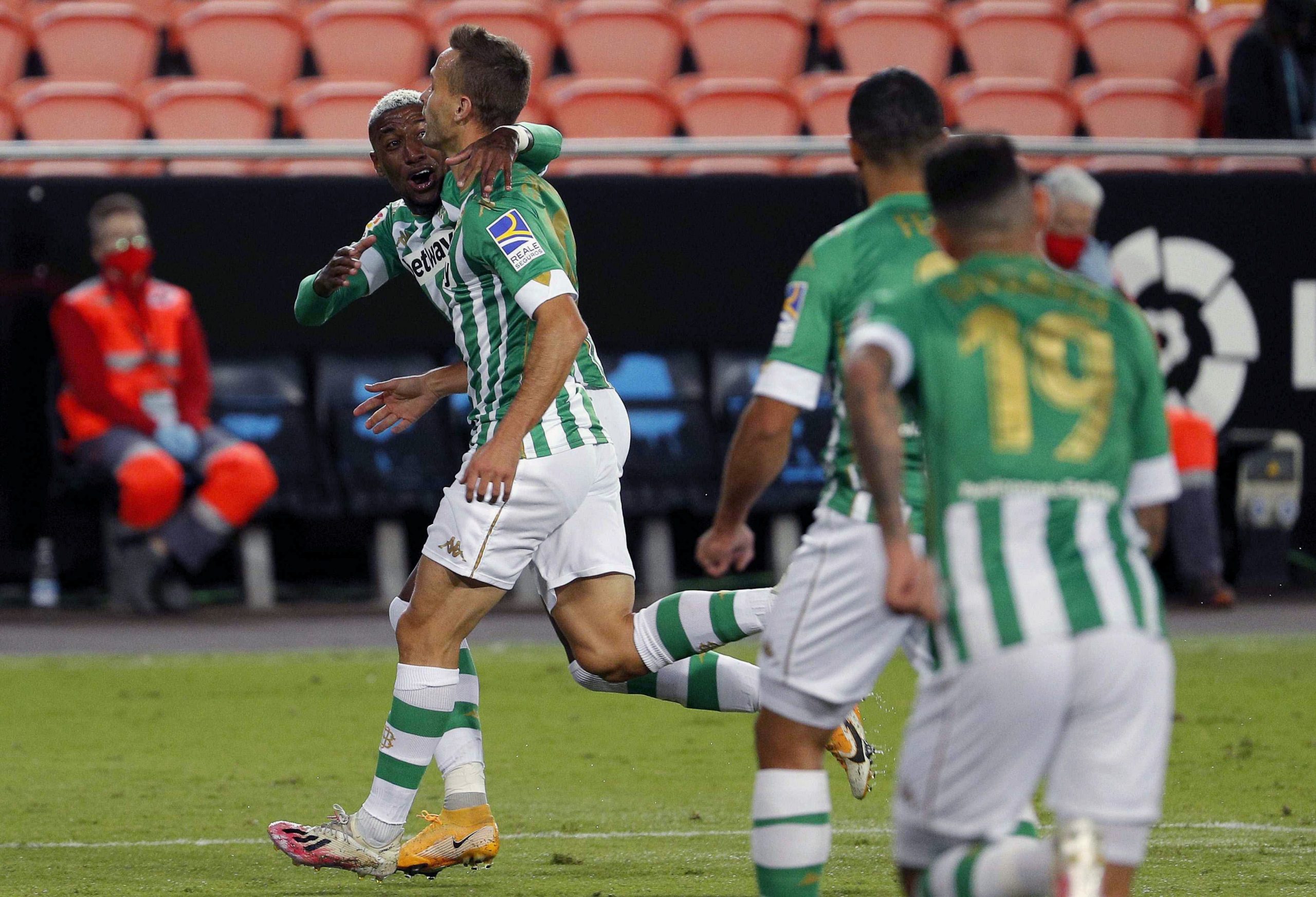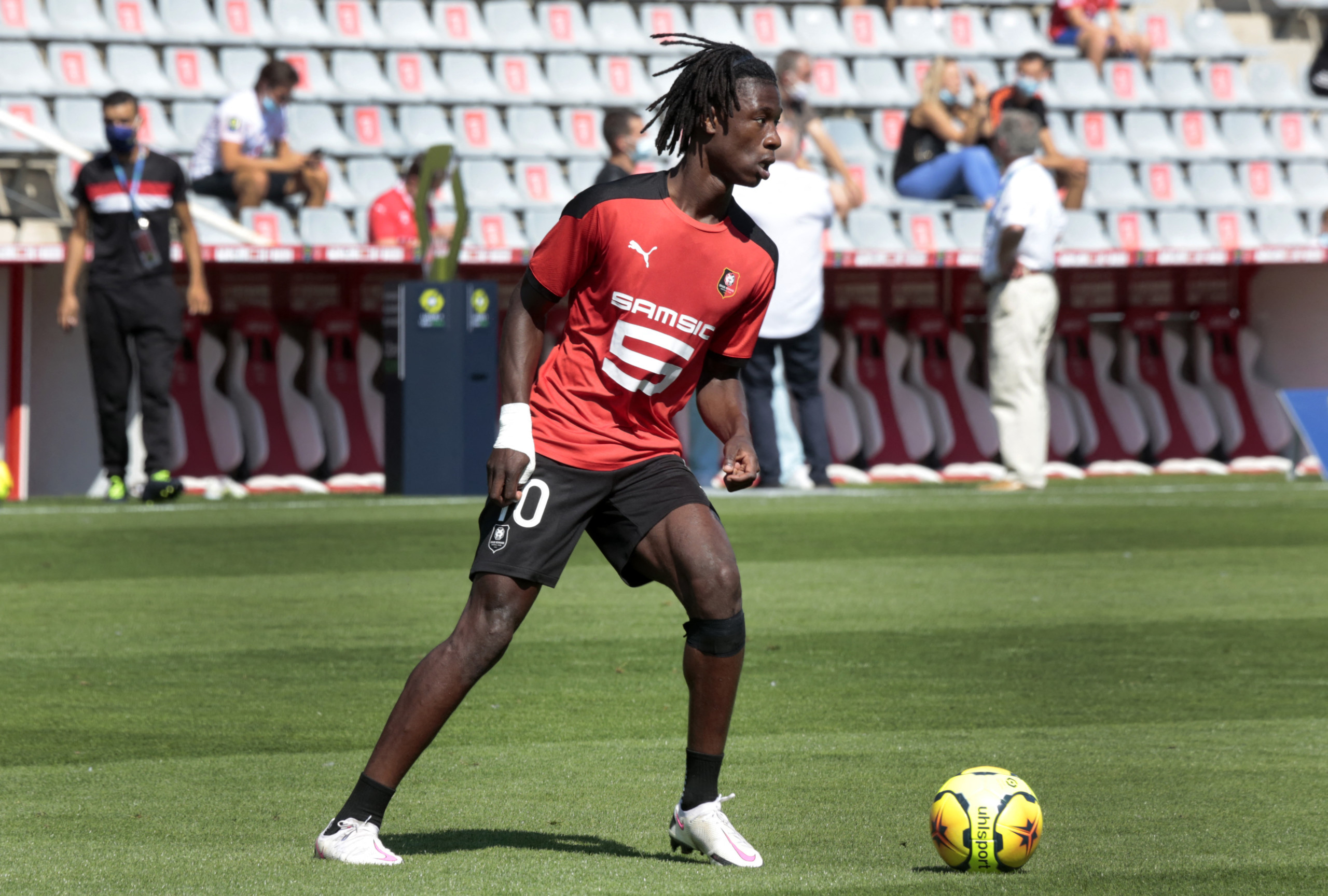We complete our roundup of the first five matchdays of action in the major European leagues with a look at some early trends in Serie A. The Highest Scoring of the Big Five Leagues Anyone still clinging to that age-old stereotype of Italian football being boring and defensive needs to readjust to the current reality: Serie A is the highest scoring major league in Europe. Just a glance at last weekend’s results provides a flavour of what the league is now producing. There were two 3-3s, a 4-2, a 3-2 and a 2-2. Not a single encounter ended scoreless. In fact, there has only been one 0-0 draw in the 48 matches (actually) played so far this season. Serie A saw a stable 2.68 goals, between 2.43-2.44 non-penalty goals and 2.36-2.39 expected goals (xG) per match through the 2017-18 and 2018-19 seasons, but those figures shot up to 3.04 goals, 2.64 non-penalty goals and 2.54 xG last time around. That has increased again in the early running of the new campaign, with an average of 3.75 goals per match. That isn’t inflated by an abnormally high penalty count either, as around one penalty goal for every three matches is consistent with the recent average across the major leagues. The average of 3.44 non-penalty goals per match is also comfortably the highest mark across the big five. The early pace is eventually likely to ease off a little. That average of 3.44 non-penalty goals per match is around 116% of the xG sum of 2.96, which is marginally higher than the highest overperformance in any 48-match sample last season, although nowhere near as extreme as the 130% rate across the first five matchdays of the Premier League season. The xG sum itself is also comfortably ahead of any 48-match sample last season. But unless something dramatic occurs, Serie A will remain the prime choice for goal hungry viewers. Just maybe don’t tune in to Hellas Verona. Their matches were some of the lowest scoring in the league last season, and that has carried over into the new campaign, with their encounters featuring the lowest number of both goals (1.40) and xG (2.41). Finally a New Champion? Juventus are seeking a 10th consecutive Serie A title this season, but it is probably fair to say that their long run of successes is in more danger of coming to an end this time around than in any previous campaign. That is partly because of their own level. Last season’s total of 83 points was their lowest in any season in their title-winning streak, and they only had the fourth-best metrics in the division. It is actually necessary to go back to 2016-17 to find the last time Juve had the best underlying numbers in Serie A, despite the fact they’ve continued to accumulate titles. The gift of three points from their unplayed match against Napoli has helped them take nine from their opening five matches of the new campaign, but they’ve not looked convincing in Andrea Pirlo’s first steps as a head coach. Inter and Napoli both had marginally better underlying numbers last season and have both picked up more points with better metrics in the early running of 2020-21. Antonio Conte and Inter finished just a point behind Juventus last season and look particularly well-placed to challenge strongly. In fact, most bookmakers now have them as the favourites for the title. But there is also another potential challenger in the form of early leaders AC Milan, who have carried their excellent form from the back end of last season into the new campaign. No team picked up as many points as the Rossoneri between the resumption of action in June and the end of the season, and only Inter had better metrics. 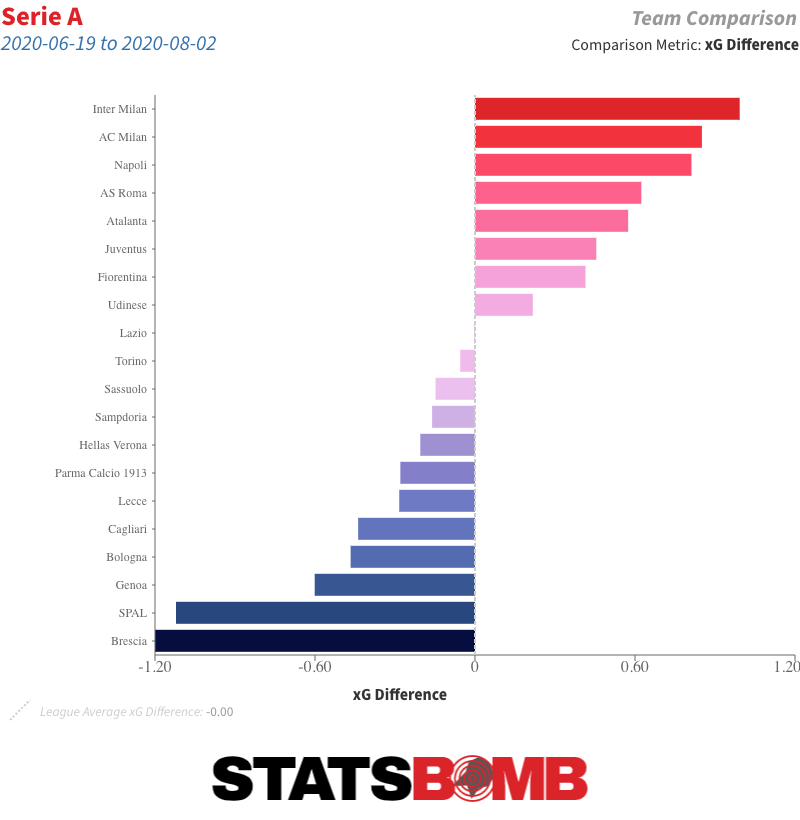 Milan’s recent focus on the signing of the young players seems to be bearing fruit, although it is notable that Zlatan Ibrahimović has been their primary goalscorer since his return in January. We’re not sure if it says more about Ibrahimović or the openness of the league that he’s still putting up numbers like this at the tail end of his 30s.
Milan’s recent focus on the signing of the young players seems to be bearing fruit, although it is notable that Zlatan Ibrahimović has been their primary goalscorer since his return in January. We’re not sure if it says more about Ibrahimović or the openness of the league that he’s still putting up numbers like this at the tail end of his 30s.  We haven’t even mentioned Atalanta yet, arguably the most entertaining team in Europe, and certainly the one with the best metrics in Serie A last season. They’ve made a slightly less impressive start to the new campaign, although their matches remain the most open in the league, with 4-2, 4-1 and 5-2 victories followed by 4-1 and 3-1 defeats.
We haven’t even mentioned Atalanta yet, arguably the most entertaining team in Europe, and certainly the one with the best metrics in Serie A last season. They’ve made a slightly less impressive start to the new campaign, although their matches remain the most open in the league, with 4-2, 4-1 and 5-2 victories followed by 4-1 and 3-1 defeats.
Month: October 2020
Building up from the back: How Borussia Dortmund try to make their way through the crowd
Borussia Dortmund are in a tough spot. The German powerhouse have established themselves among the best teams in Europe and even more so in the Bundesliga where there is a considerable gap between Dortmund, Bayern Munich, RB Leipzig and the rest of the pack. Dortmund are expected to command the action on the pitch, and they themselves like to be in command.
Lucien Favre is certainly one of those managers that believe in possession and flawless passing as a way to dominate and drain the energy out of opponents. While flawless passing with infrequent shooting can seem dull to some, it is a technique to move opponents around and wait until there is the opening needed to advance quickly down the field. After all, Dortmund are at their strongest when the attacking cohort around Erling Haaland is moving at a rapid pace in open space.
The result from this is that Dortmund’s build-up play might be the most pivotal part of their game. BVB have, on average, 111 possessions per 90 minutes. However, as opposed to many other teams, a single possession usually consists of several build-up attempts, in particular because of Favre demanding from players to abandon an attacking play and start all over again from the back rather than desperately trying to force a shot with little to no chance of success.
“Of course my wish is that we can play through our entire team, starting from the goalkeeper, finding intelligent ways to get to the goal.” (Lucien Favre)
What are the key components of Dortmund’s build-up?
After tinkering with tactical line-ups involving a back four during pre-season, Favre decided to stick to the back three he successfully used for major parts of last season. He made slight adjustments to the structure in front of the back line, most notably the implementation of a mobile no. 10 in Gio Reyna, though the young American has also been used as a no. 10-winger hybrid when Favre went back to last season’s 3-4-2-1 in Dortmund’s recent encounter with Hoffenheim. That being said, the build-up structure has not changed. The only significant personnel change, as Thomas Meunier has replaced Achraf Hakimi, has had an impact on the forcefulness of Dortmund’s attack but less so on the early stages of the build-up.
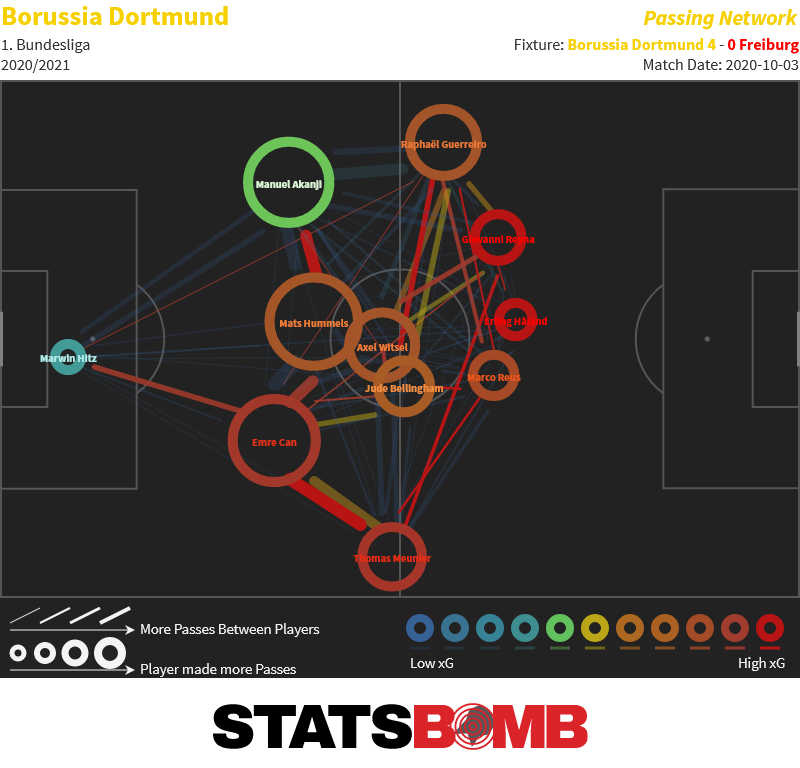
That build-up is usually done with a certain degree of urgency, particularly when Dortmund’s three defenders are pressured by a clear-cut man-marking scheme as seen in BVB’s match against SC Freiburg. The three defenders then attempt to move the ball laterally as quickly as possible, hoping that the opposing pressing line cannot keep up and offer openings that will allow Dortmund to bring the ball into the central midfield – which is the central component of the entire build-up. Dortmund always attempt to move the ball downfield through the middle of the field. While it might seem at times that Dortmund’s formation is stretched and the plays go to the outside, the main objective of the early build-up is to make use of Axel Witsel, Jude Bellingham and Gio Reyna, meaning to give them touches behind the first and occasionally second pressing line.
The rapid speed at which the three central defenders try to move the ball laterally leads quite naturally to passes towards the touchline, as it would, otherwise, be impossible to keep the ball going within the limited amount of space the back three occupies. This results in the two wing-backs being involved in the early phase of the build-up. Unfortunately, Meunier has not fully adapted to that aspect of the build-up, as he likes to advance quite quickly, but then finds himself in no-man's-land up the field, as the right-sided centre-back is desperately trying to play the ball to the outside. Meunier then has to rush back and receive the pass, though in a position that lets him face Dortmund’s goal and more or less forces him to play the ball backwards immediately. The left wing-back usually sits deeper and thus is positioned with a better body posture that allows him to play into the midfield centre after receiving a pass from the back three.
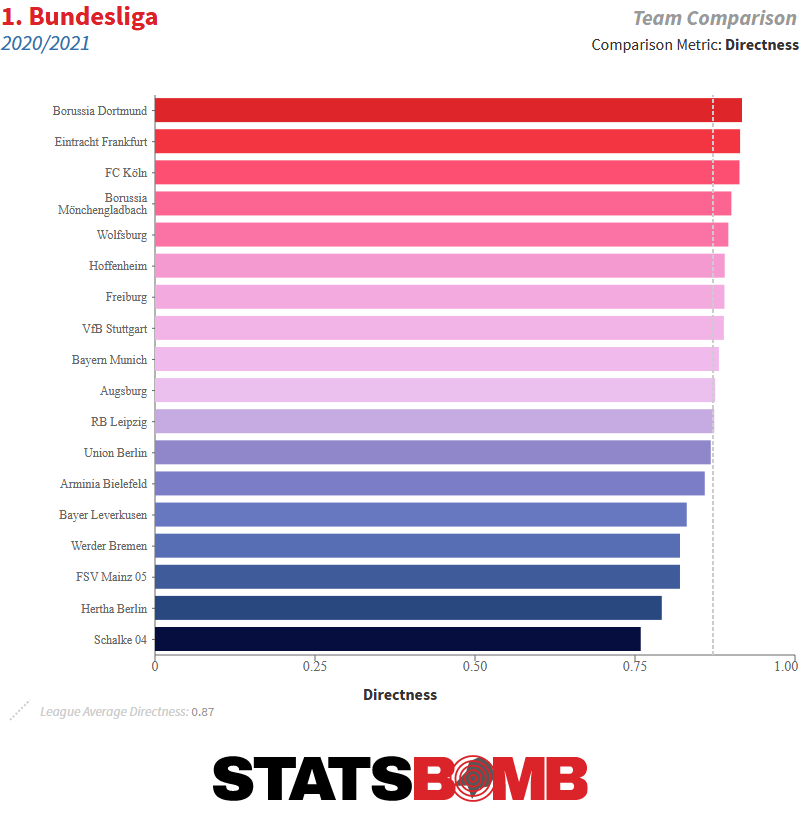
Dortmund’s attacks are currently the most direct in the Bundesliga. They finished second in this category last season. (‘Directness’ is a ratio of the distance towards goal from the start of a possession that ended in a shot, divided by the total distance travelled in build-up to the shot.)
This brings us to another key component of Dortmund’s build-up – diagonality, is created differently by the individual build-up players. First, there is Emre Can as the right-sided centre-back who likes to advance through the half-space, often moving slightly diagonally to break through flat pressing lines which don’t have the angle to close the gaps quickly enough. Statistically, Can is among the top 5 Bundesliga players in ‘progressive carrying distance’. Second, there is Manuel Akanji who plays as a right-footer on the left side and naturally tends to play diagonal passes into the midfield.
Third, there is Raphael Guerreiro who, as the left wing-back, often sits deeper to get a clear look at the field before playing the ball with his left foot either down the line or into the middle. Fourth, there is Felix Passlack who can quite effortlessly adapt his game and play as a left wing-back despite the right foot being his stronger one. Passlack knows that he has to turn his body towards the centre before receiving a pass from one of the central defenders in order to use his right foot and directly play a slightly curved pass into the middle.
While Passlack has done well in becoming a valuable part of Dortmund’s build-up, Guerreiro rightfully remains a linchpin of this phase in the game. Because of his proximity to the touchline, mixed with his deep position, he can play the inside pass at a sharp angle to Bellingham or Witsel who then follow up with a direct pass at a similar angle back to the wing. That pass is often ensued by a pass towards Haaland who is able to use the way Dortmund gain room through this sort of triangle on the left side to create separation from his defenders and make a run behind the last line.
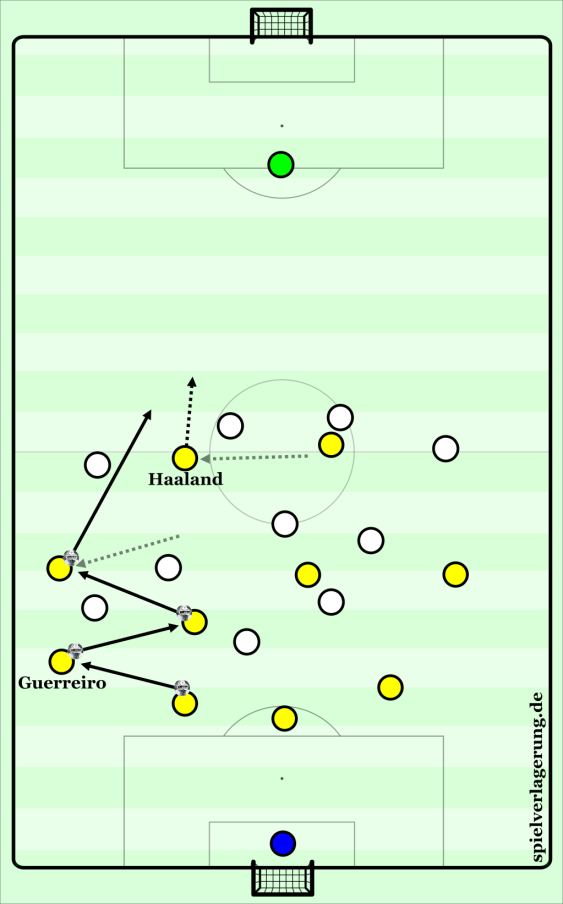
That is, in a simplified way, how a passing chain involving Guerreiro occasionally looks.
Contributing factors
Many opponents think they have to meet Dortmund’s build-up with a high press coupled with a man-marking scheme that at least assigns markers to Mats Hummels and Emre Can. If these markers confront Dortmund’s defenders intensely, forcing them to quickly decide whether lateral ball movements are safe enough, BVB often switch to direct vertical passing. Even if a pressing player stands directly in front of Can, the Dortmund player can still find a way to pass the ball around the opponent at a slight angle, moving it vertically down the field. In that regard, Gio Reyna plays a crucial role, as he is usually the attacking player that makes the most lateral runs 20 or so yards down the field and can establish a position in a vertical channel linked to the right-sided or left-sided centre-back. Reyna’s mobility and relentless style of constant movement are key to breaking high presses.
What Reyna is to Can is Bellingham to Hummels, as the young Brit also likes to create separation from his marker and position himself in the channel in front of one of the centre-backs. His teammates already trust Bellingham to such a degree that they even target him as a receiver when he is in a crowded spot in the middle third. In recent years, Dortmund were lacking the kind of box-to-box midfielder that can thrive next to Witsel. At the age of 17, Bellingham has clearly shown an aptitude for progressive passing during the short time at the club and already appears to be a self-assured ball carrier that may not crack under the unique pressure most Bundesliga teams put on centre-midfielders.
Bellingham often uses the left half-space to call for a vertical pass, as he usually is higher up the pitch than Witsel. With Reyna tending to drop back through the right half-space, the two 17-year-olds effectively form a temporary no. 8 pairing in Dortmund’s build-up, creating a triangle with Witsel who has devoted himself to covering the backs of these two youngsters. That midfield triangle is usually narrower than the back three which, again, creates diagonality when a forward pass is played.
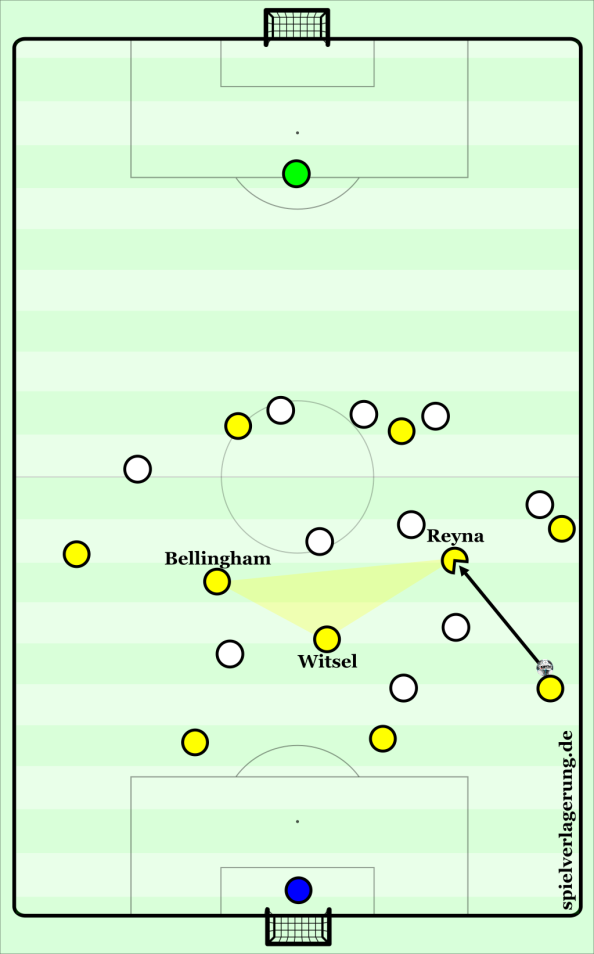
Witsel, Bellingham and Reyna form a midfield triangle. When one of the outside centre-backs, particularly Can who plays on his ‘natural’ side, is close to the touchline, it is paramount that the nearby midfielder moves out of coverage shadows and frees himself from markers to be quickly available as a receiver.
Another element that might not be a central component of the build-up, but makes Dortmund more unpredictable are Mats Hummels’s short dribbles where makes a few explosive steps from his initial position and gets past an opponent. Hummels quite regularly makes these short dribbles after receiving the ball from the left side to his right foot, immediately pushing the ball with the outside of the boot towards the centre and then following up with a few more touches in an attempt to win some spaces and provoke the opposing team to react. Hummels’s short dribbles can, at best, create a domino effect and free at least one midfielder from his marker.
The descriptions above have been made – and possibly read – under the assumption that Dortmund intend to keep passes short and the ball on the ground. It is certainly true that Favre likes ‘small ball’ much more than a style with long passes which are less controllable and usually create a considerable amount of chaos. That said, Dortmund are quite adept in sparingly employing long balls. These are most effective after Dortmund have advanced and decided to play the ball back to the defenders who immediately go for a long diagonal ball to a player on the far side or an attacker making a run behind the offside line. In that scenario, Dortmund smartly exploit the momentum of the opposing defence.
Pitfalls
There are certainly a few pitfalls that could endanger Dortmund’s success in the early phase of their build-up. Recent performances against Augsburg and Lazio have made that crystal clear.
Emre Can and his half-space runs are rightfully praised as a tool to break pressing lines, as such runs are commonly effective against most defences. However, Can tends to be a bit reckless with his forward movement, likely channelling his inner midfielder who wouldn’t face severe consequence in case of a turnover. Playing at the back means that he has to decrease the risks he takes when he attempts to disturb pressing structures. The fact that he makes so many progressive runs successfully can be seen as a positive, but knowing Favre and how calculated—or some could say risk-averse—he is, it is hard to believe that the Swiss doesn’t raise an eyebrow when Can decides it is time to take on two or three defenders.
The reason Can’s progressive runs usually work is that he can exploit vast chunks of space between opposing pressing lines. Most opponents believe they have to attack Dortmund early and intensely, not giving them any time in the first phase of the build-up. They fear that a competent passer like Hummels could catch them with his accurate vertical balls or hit a perfect pass over the top of the back line as he has done so many times in the past. But those teams that sit back a bit are usually more successful against BVB.
Hoffenheim, for instance, did not apply a high press in their recent match against Dortmund and instead created density in the middle third. Similarly, Lazio did not constantly use a high press, as they invited BVB to move a bit and then brought Dortmund to a halt, as the Italians intended to force backwards passes and passes to deep-sitting wing-backs. These passes by Dortmund were used as triggers by Lazio who quickly advanced and closed down passing options close to Dortmund’s ball carrier.
Dortmund’s build-up players usually take the bait and move a couple of yards forward, making the pitch more narrow and thus destroying space that could otherwise be used for medium-range passes to Bellingham, Witsel or Reyna. Once Hummels and his teammates are at the halfway line, any kind of vertical pass to one of the midfielders is usually short and somewhat slow, because a forceful pass would only increase the risk of an unclean touch by the receiver. But the shortness of the pass and the density don’t allow the receiver to make a quick and safe 180-degree turn towards the penalty area.
Another factor that could harm Dortmund’s build-up are injuries. Favre has been forced to change the line-up of his back three quite frequently in recent weeks. Thomas Delaney being slotted into the role of the left-sided centre-back against Hoffenheim and Lazio was nothing more than an emergency decision by the Swiss coach, although Delaney did quite well in this unfamiliar role. Still, an established line-up with Hummels, Can and possibly a fully fit Dan-Axel Zagadou would help Favre to hone the positional play and improve the accuracy and effectiveness of passing chains.
While there is certainly enough room for improvement, as shown by Dortmund’s disappointing performance against the pressing experts of FC Augsburg and the astute defenders of Lazio, BVB’s build-up provides a decent base for the attacks by the Black and Yellows. After all, there is no doubt that Jadon Sancho, Marco Reus and Erling Haaland are one of the most talented attacking trios in Europe. That Dortmund get the ball to them is what matters.
This post is also available in German here
The Big 5 After 5: Bundesliga
We are five matchdays into the new Bundesliga season, so let’s have a look at a couple of interesting things from the early action. Predictable Leaders The Bundesliga has taken a lot less time to shake out than many of the other major European leagues, with the top three spots in the table currently filled by the top three teams from last season: Bayern Munich, Borussia Dortmund and RB Leipzig. Not only that, but the three of them also have the best underlying numbers in the division. Aside from a surprise 4-1 defeat away to Hoffenheim, champions Bayern are humming along just fine, scoring four or more goals in each of their four victories. Dortmund also have a loss on the board, but have won all of their remaining matches to nil. RB Leipzig lead the way early on with four wins and a draw from a kinder opening schedule. Even at this extremely early stage of the campaign, it would take a brave person to back another team to finish in the top three, and perhaps an even braver one to back anyone but Bayern for the title. Hans Flick’s side finished 13 points clear of second last season after winning nine on the bounce following the return to play to May, and then successfully made their way through the final four rounds of the Champions League to become champions of Europe. Aside from that Hoffenheim anomaly (4-1 on the scoreboard; 3.98-1.64 by expected goals), they’ve been dominant so far, outshooting their remaining opponents 79-33, and accumulating 13.44 xG while conceding just 3.48. We are only five matches in and the usual caveats about small sample sizes obviously still apply, but it is difficult to see Bayern relinquishing their mightily firm grip on the Bundesliga title. Robert Lewandowski has also made a great start in his attempt to finish the season as the league’s top scorer for a fourth consecutive campaign. 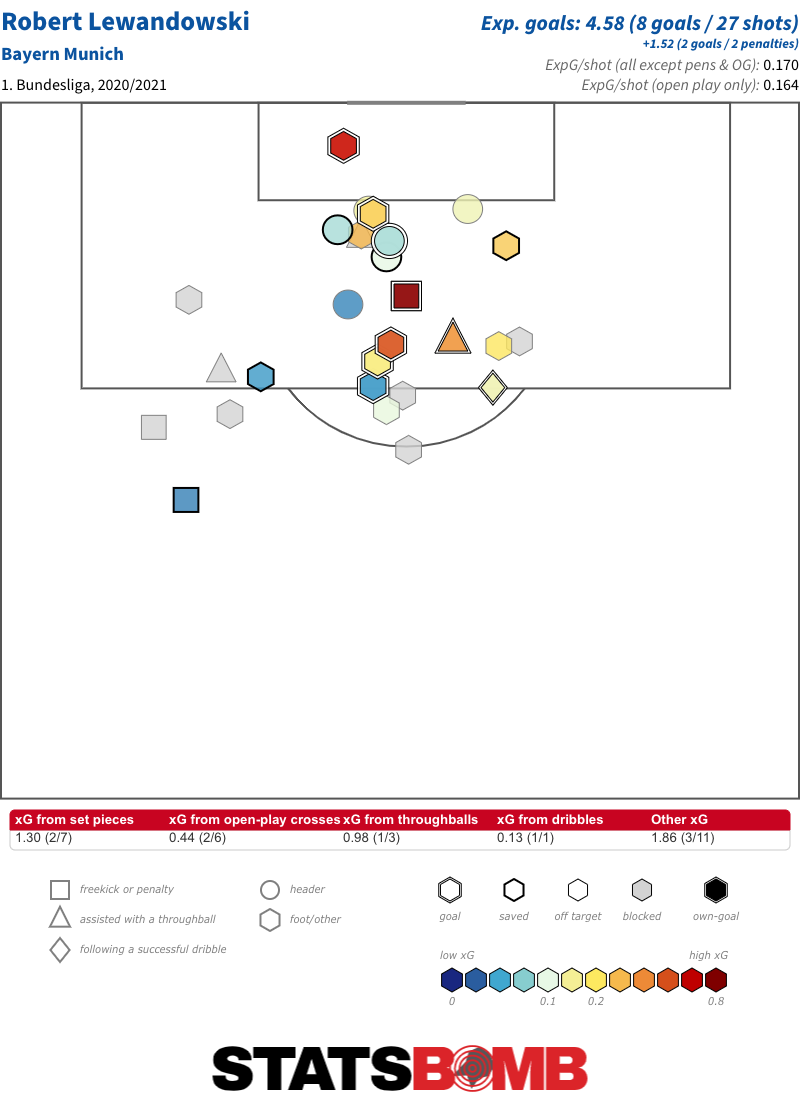 How bad are Schalke? Schalke are second from bottom after picking up just a single point from their opening five fixtures. More globally, they are now winless in their last 21 Bundesliga matches -- the joint second worst run in the history of the league. Their one and only league win this calendar year came way back on 17th January in a 2-0 triumph at home to Borussia Mönchengladbach. Are they really that bad? In a certain sense, the answer is yes. With penalties included, they’ve given up an average of over two goals per match to their opponents during this run. Extrapolated to a full campaign that would have resulted in comfortably the worst goal difference in the Bundesliga last season. With penalties removed, the average drops to 1.86, which is some way ahead of their average xG deficit of 0.98 per match, but that latter figure would still again have comfortably been the worst in the league last season. So we can pretty confidently state that as currently constituted, Schalke are a bad team. Even so, the likelihood of them putting together a run of 21 matches without victory is still very low. The race charts in StatsBomb IQ display the probability of a match ending in a home win, an away win or a draw based on the balance of chances. We can use these probabilities from each of the 21 matches in their winless streak to establish the cumulative probability of them failing to secure a single victory in that time. It’s worth noting that they are some dreadful performances in here, including four matches in which Schalke’s opponents had a 90% or better chance of winning given the balance of chances. Only once did Schalke’s win probability stand at over 50%. There was an 80% or better chance of them failing to win in 14 of the 21 matches. But if you stack them all, even a team playing as badly as they have done during this run would usually have sneaked a victory or two along the way. The probability of them failing to win all 21 of the matches stands at just under 1.5%. So while performances this calendar year and since the start of this season certainly have Schalke pegged as likely relegation candidates, it wouldn’t be at all surprising if they were to bring their winless run to an end before they reach the Bundesliga record of 31 matches without victory, set by Tasmania Berlin way back in the mid-sixties.
How bad are Schalke? Schalke are second from bottom after picking up just a single point from their opening five fixtures. More globally, they are now winless in their last 21 Bundesliga matches -- the joint second worst run in the history of the league. Their one and only league win this calendar year came way back on 17th January in a 2-0 triumph at home to Borussia Mönchengladbach. Are they really that bad? In a certain sense, the answer is yes. With penalties included, they’ve given up an average of over two goals per match to their opponents during this run. Extrapolated to a full campaign that would have resulted in comfortably the worst goal difference in the Bundesliga last season. With penalties removed, the average drops to 1.86, which is some way ahead of their average xG deficit of 0.98 per match, but that latter figure would still again have comfortably been the worst in the league last season. So we can pretty confidently state that as currently constituted, Schalke are a bad team. Even so, the likelihood of them putting together a run of 21 matches without victory is still very low. The race charts in StatsBomb IQ display the probability of a match ending in a home win, an away win or a draw based on the balance of chances. We can use these probabilities from each of the 21 matches in their winless streak to establish the cumulative probability of them failing to secure a single victory in that time. It’s worth noting that they are some dreadful performances in here, including four matches in which Schalke’s opponents had a 90% or better chance of winning given the balance of chances. Only once did Schalke’s win probability stand at over 50%. There was an 80% or better chance of them failing to win in 14 of the 21 matches. But if you stack them all, even a team playing as badly as they have done during this run would usually have sneaked a victory or two along the way. The probability of them failing to win all 21 of the matches stands at just under 1.5%. So while performances this calendar year and since the start of this season certainly have Schalke pegged as likely relegation candidates, it wouldn’t be at all surprising if they were to bring their winless run to an end before they reach the Bundesliga record of 31 matches without victory, set by Tasmania Berlin way back in the mid-sixties.
Argentina Copa de la Liga Profesional 2020 Season Preview
Football returns to Argentina this week following a seven-month absence due to the COVID-19 pandemic. Vicente Muglia, Olé journalist and author of the book Che Pep, joins us to preview the Copa de la Liga Profesional 2020, which opens with Gimnasia La Plata against Patronato on Friday. Nick Dorrington, Content Manager at StatsBomb (ND): Hi Vicente. Thanks for giving up your time to speak to us. We are going to kick off with the top two from last season (the Superliga 2019-20), River Plate and the champions Boca Juniors, two teams with differing approaches. Could you summarise the key points of their respective play styles? Vicente Muglia (VM): Throughout Marcelo Gallardo’s tenure, River have stood out as a team who take the initiative in two ways: through possession and with a high press. When they have the ball, they are a dangerous team because they are quite direct, they don’t chain together a lot of passes but instead seek to move forward, take advantage of space or create it, all by means of an unwavering tactical intensity. Without the ball, they have a well-oiled pressing system which is consistently effective in winning it back. The forwards are the team’s first defenders. When they win the ball back in opposition territory, they attack decisively to take full advantage of the transitional phase. ND: It is something that is clearly visible in the data. Last season, River utilised an aggressive high press, with only Argentinos Juniors contesting the ball more intensely in opposition territory. 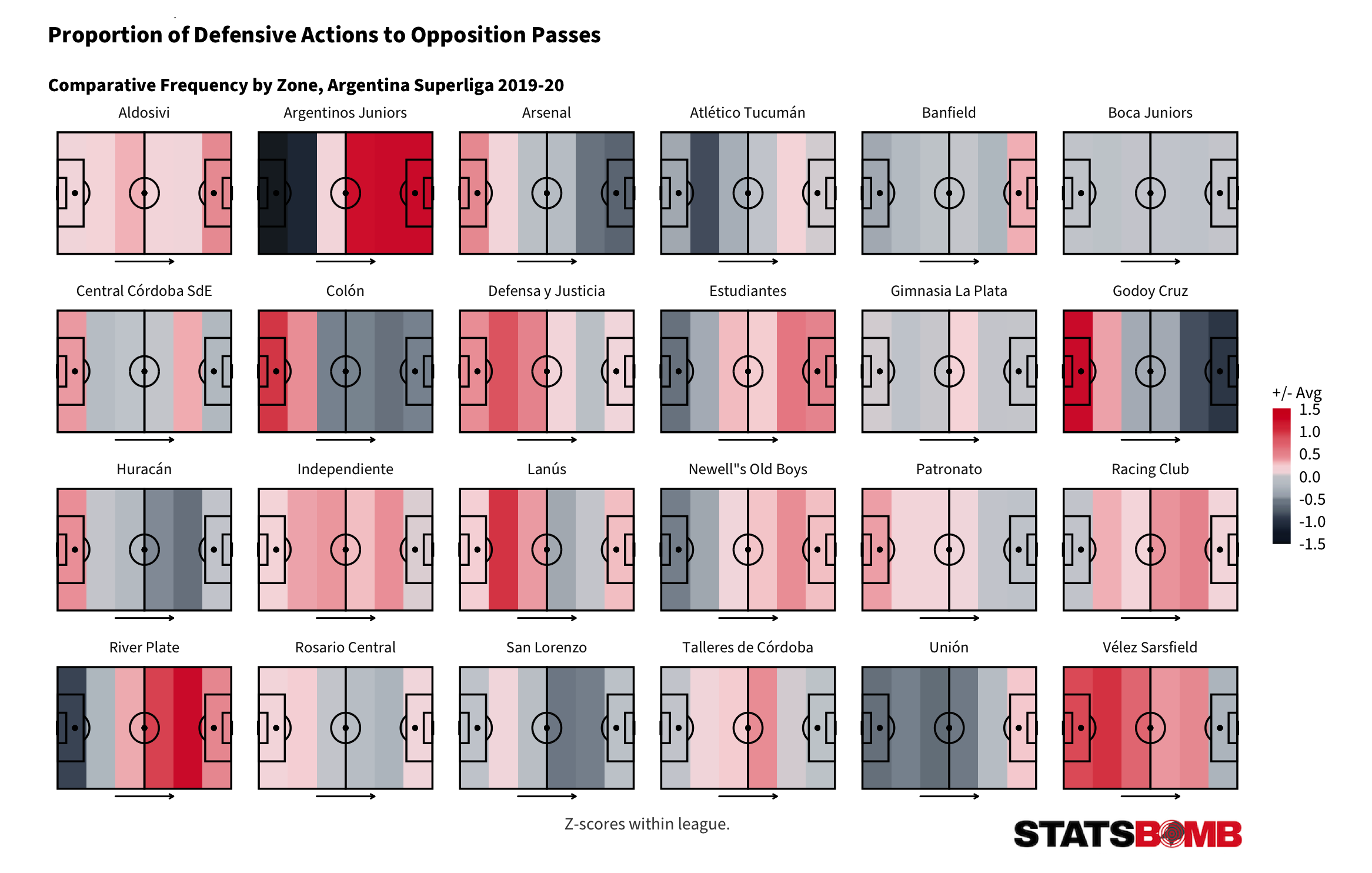 River were also the team who generated the most shots after winning the ball back high up the pitch.
River were also the team who generated the most shots after winning the ball back high up the pitch. 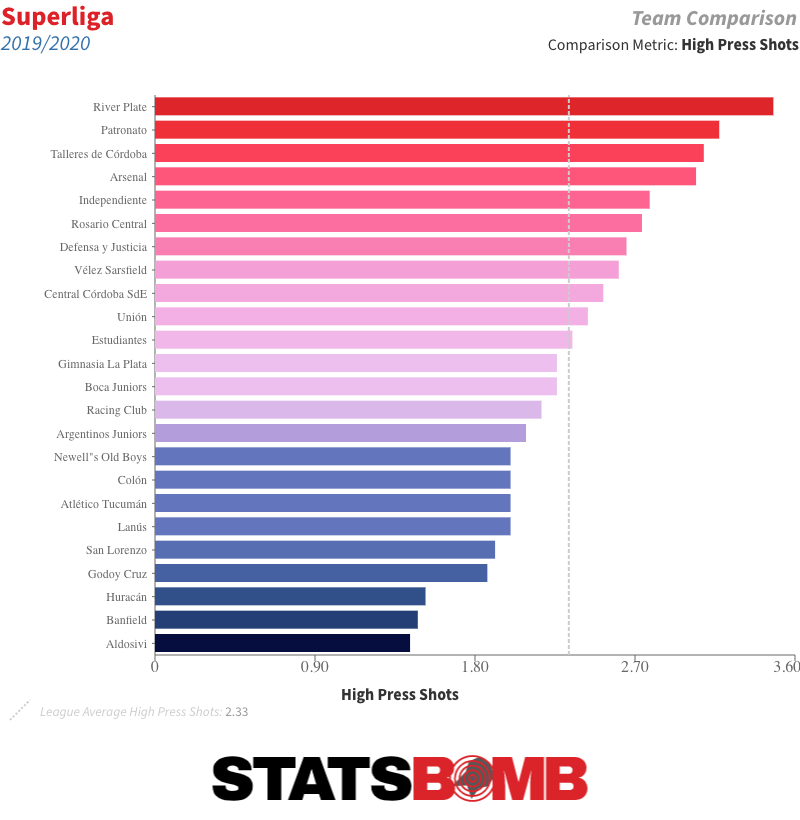 Both visualisations make it clear that Boca, coached by the experienced Miguel Ángel Russo, have a very different play style. VM: Yes. In contrast to River, Boca don’t usually press high but instead focus on winning the ball back in the centre of the pitch and then attacking quickly from there. They are a direct team, who don’t elaborate as much as River. The key to last season’s championship was the damage they did down the flanks. Julio Buffarini and Eduardo Salvio on the right and Frank Fabra and Sebastián Villa on the left spread the pitch, got in behind and destabilised opposing defences. Boca also had the very steady Jorman Campuzano in midfield, and Carlos Tévez up front, who was intelligent in finding space and rationing his efforts. ND: In addition to being the team’s top scorer, Tévez played a very important role in ball progression. He dropped back to receive and combine with teammates, and on a per-90 basis, only Emanuel Reynoso, now of Minnesota United in MLS, moved the ball into the final third more often and played more open play passes into the penalty area than Tévez.
Both visualisations make it clear that Boca, coached by the experienced Miguel Ángel Russo, have a very different play style. VM: Yes. In contrast to River, Boca don’t usually press high but instead focus on winning the ball back in the centre of the pitch and then attacking quickly from there. They are a direct team, who don’t elaborate as much as River. The key to last season’s championship was the damage they did down the flanks. Julio Buffarini and Eduardo Salvio on the right and Frank Fabra and Sebastián Villa on the left spread the pitch, got in behind and destabilised opposing defences. Boca also had the very steady Jorman Campuzano in midfield, and Carlos Tévez up front, who was intelligent in finding space and rationing his efforts. ND: In addition to being the team’s top scorer, Tévez played a very important role in ball progression. He dropped back to receive and combine with teammates, and on a per-90 basis, only Emanuel Reynoso, now of Minnesota United in MLS, moved the ball into the final third more often and played more open play passes into the penalty area than Tévez. 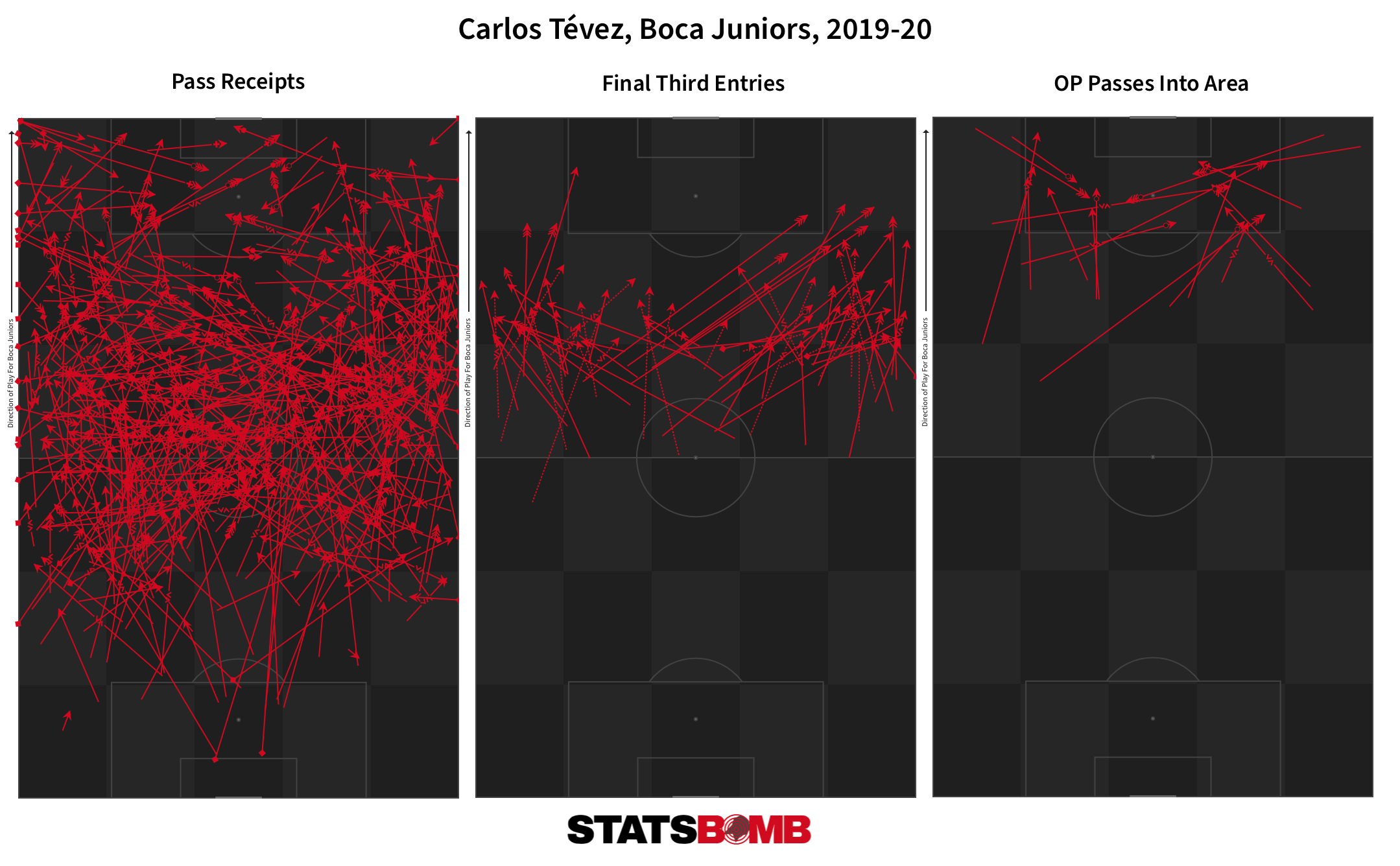 How are Boca and River looking ahead of this tournament? The format is a bit convoluted and so luck is likely to play a larger role than it would in a traditional league format, but are they still the two favourites to win it? VM: Even though River have lost Lucas Martínez Quarta and Juan Fernando Quintero, and Boca are unable to count on Villa due to off-pitch issues, they are still the two strongest teams in Argentinian football both in terms of collective performances and individual quality. They have the two best squads. Without a doubt, they remain the main candidates to lift the trophy. Prior to the start of the tournament, I don’t see another team equipped to compete with them for the trophy in normal conditions. ND: It’s worth mentioning that River had the best expected goal (xG) difference last season, and by some distance.
How are Boca and River looking ahead of this tournament? The format is a bit convoluted and so luck is likely to play a larger role than it would in a traditional league format, but are they still the two favourites to win it? VM: Even though River have lost Lucas Martínez Quarta and Juan Fernando Quintero, and Boca are unable to count on Villa due to off-pitch issues, they are still the two strongest teams in Argentinian football both in terms of collective performances and individual quality. They have the two best squads. Without a doubt, they remain the main candidates to lift the trophy. Prior to the start of the tournament, I don’t see another team equipped to compete with them for the trophy in normal conditions. ND: It’s worth mentioning that River had the best expected goal (xG) difference last season, and by some distance. 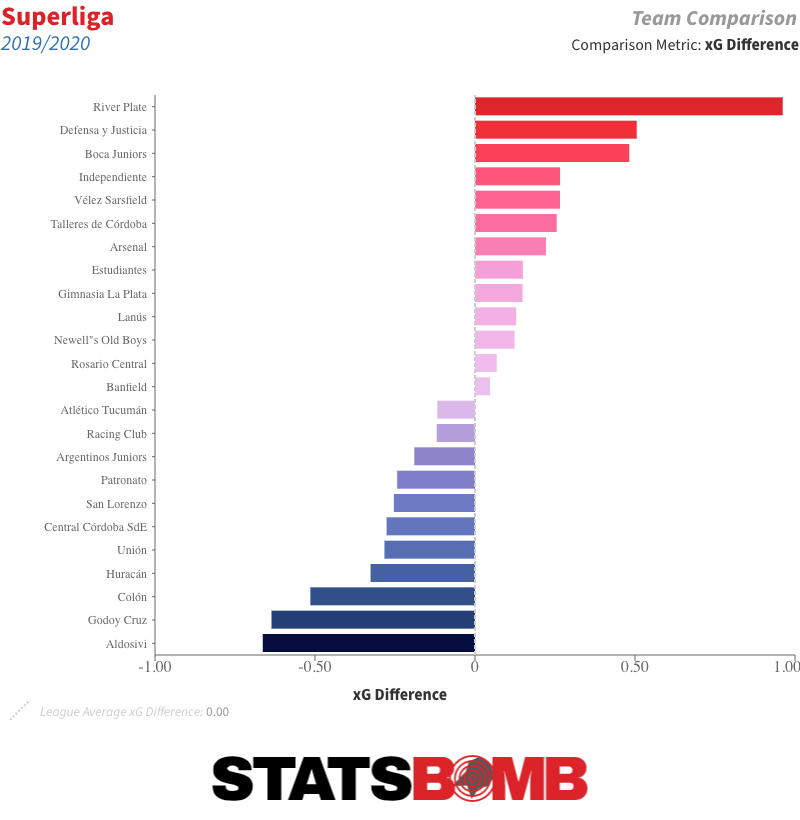 Boca performed well above expectation in defence, letting in just eight goals. Our data suggests the excellent performances of their goalkeeper Esteban Andrada were a contributory factor, but it doesn’t explain all of the difference. It is unlikely they will again concede so few goals.
Boca performed well above expectation in defence, letting in just eight goals. Our data suggests the excellent performances of their goalkeeper Esteban Andrada were a contributory factor, but it doesn’t explain all of the difference. It is unlikely they will again concede so few goals. 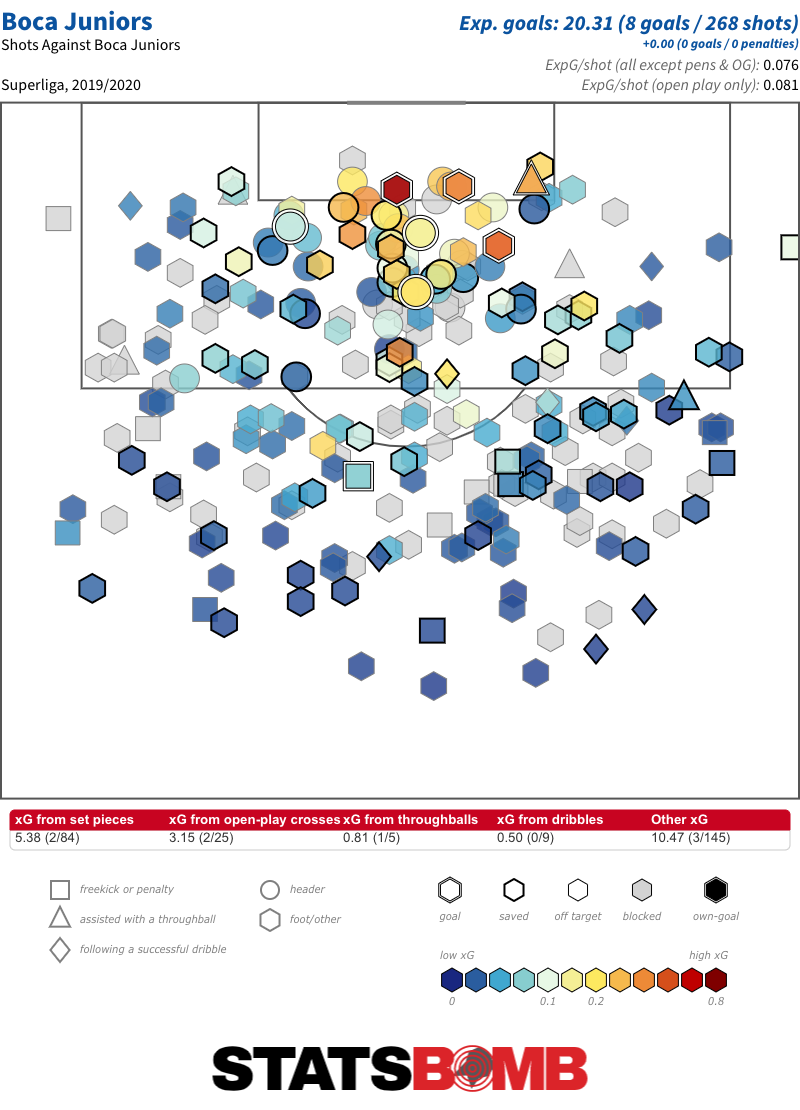 Are there some other teams with interesting play styles? VM: Racing and Defensa y Justicia have a pair of young coaches in Sebastián Beccacece and Hernán Crespo who, despite having different play styles, both seek to take the initiative and attack. They are teams who construct play from the back, move forward and are aggressive in attack. They don’t speculate. Although the feeling is that both of them need to find a bit more consistency, not only in terms of results but also in terms of their play. NM: The underlying numbers suggest that Crespo has better base to work from than Beccacece, but we will see how things play out. Another team who intrigue me are Argentinos Juniors. As we’ve already noted, they utilised a very aggressive high press last season, but they didn’t combine it with a high share of possession. They were a much more direct team than River or Vélez Sarsfield, for example. They finished fifth, but they scored less than a goal per match and struggled to create good quality chances.
Are there some other teams with interesting play styles? VM: Racing and Defensa y Justicia have a pair of young coaches in Sebastián Beccacece and Hernán Crespo who, despite having different play styles, both seek to take the initiative and attack. They are teams who construct play from the back, move forward and are aggressive in attack. They don’t speculate. Although the feeling is that both of them need to find a bit more consistency, not only in terms of results but also in terms of their play. NM: The underlying numbers suggest that Crespo has better base to work from than Beccacece, but we will see how things play out. Another team who intrigue me are Argentinos Juniors. As we’ve already noted, they utilised a very aggressive high press last season, but they didn’t combine it with a high share of possession. They were a much more direct team than River or Vélez Sarsfield, for example. They finished fifth, but they scored less than a goal per match and struggled to create good quality chances. 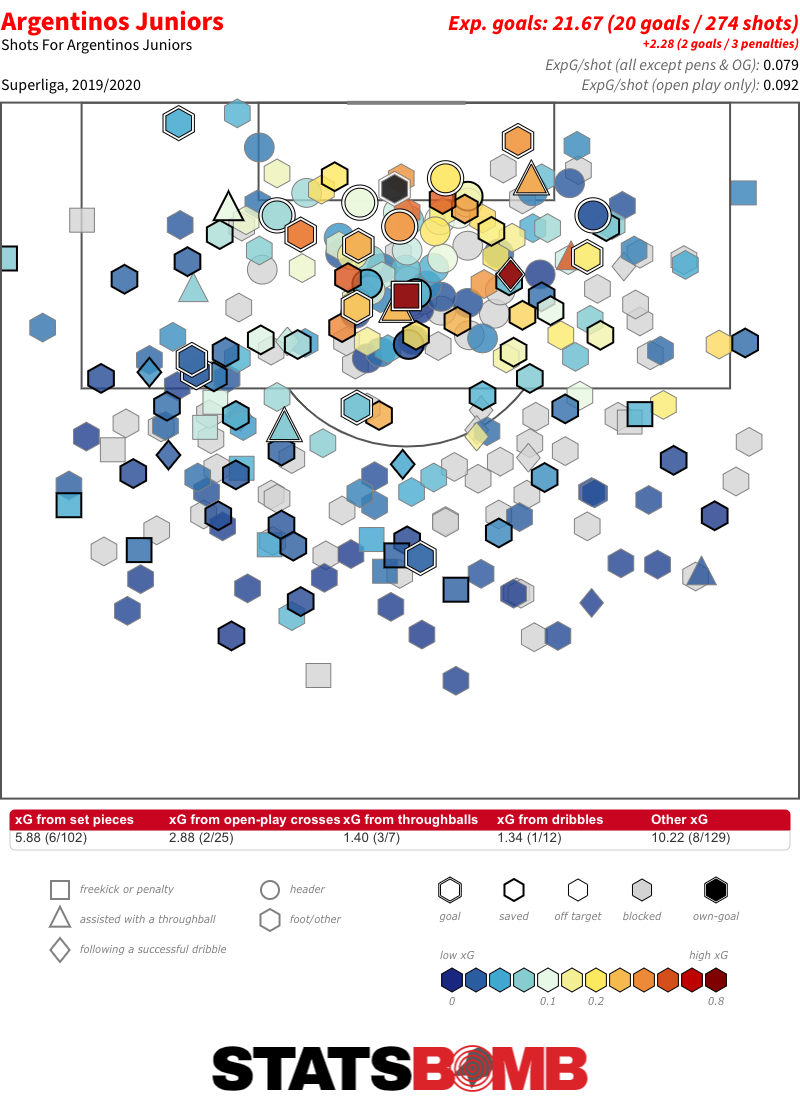 It will be interesting to see if Diego Dabove is capable of developing that aspect of their game. Have there been any interesting coaching changes? VM: Mauricio Pellegrino has replaced Gabriel Heinze at Vélez. It will be a big challenge for the club to maintain the level of competitiveness they had under Heinze, who elevated both the individual and collective level with an approach based around positional play. Pellegrino, returning to the country after a number of years in Europe, is more focused on maintaining balance. He takes less risks. We’ll have to see how the squad adapt to his style. ND: It’s a significant shift. If we take another look at the PPDA by Zone graphic above, we can see that Heinze’s Vélez pressed aggressively across pretty much the entire pitch. It looks very similar to what we see from Marcelo Bielsa’s teams. In contrast, Pellegrino was a much more reactive coach during his time in Spain, although admittedly with smaller teams. VM: There is also Mariano Soso, a young coach with some interesting ideas based around a distinctly attacking approach, who has taken charge at San Lorenzo. There, too, it remains to be seen whether he can convince his players to carry out his game model. ND: Which team made the best moves in the transfer market? VM: Due to the pandemic, there haven’t been many big moves in this window. I think Estudiantes de La Plata made the best signings. They’ve strengthened with Nicolás Pasquini from Lanús, Leonardo Godoy from Talleres de Córdoba and Leandro Díaz from Atlético Tucumán, three footballers who were starters at their respective clubs last season.
It will be interesting to see if Diego Dabove is capable of developing that aspect of their game. Have there been any interesting coaching changes? VM: Mauricio Pellegrino has replaced Gabriel Heinze at Vélez. It will be a big challenge for the club to maintain the level of competitiveness they had under Heinze, who elevated both the individual and collective level with an approach based around positional play. Pellegrino, returning to the country after a number of years in Europe, is more focused on maintaining balance. He takes less risks. We’ll have to see how the squad adapt to his style. ND: It’s a significant shift. If we take another look at the PPDA by Zone graphic above, we can see that Heinze’s Vélez pressed aggressively across pretty much the entire pitch. It looks very similar to what we see from Marcelo Bielsa’s teams. In contrast, Pellegrino was a much more reactive coach during his time in Spain, although admittedly with smaller teams. VM: There is also Mariano Soso, a young coach with some interesting ideas based around a distinctly attacking approach, who has taken charge at San Lorenzo. There, too, it remains to be seen whether he can convince his players to carry out his game model. ND: Which team made the best moves in the transfer market? VM: Due to the pandemic, there haven’t been many big moves in this window. I think Estudiantes de La Plata made the best signings. They’ve strengthened with Nicolás Pasquini from Lanús, Leonardo Godoy from Talleres de Córdoba and Leandro Díaz from Atlético Tucumán, three footballers who were starters at their respective clubs last season. 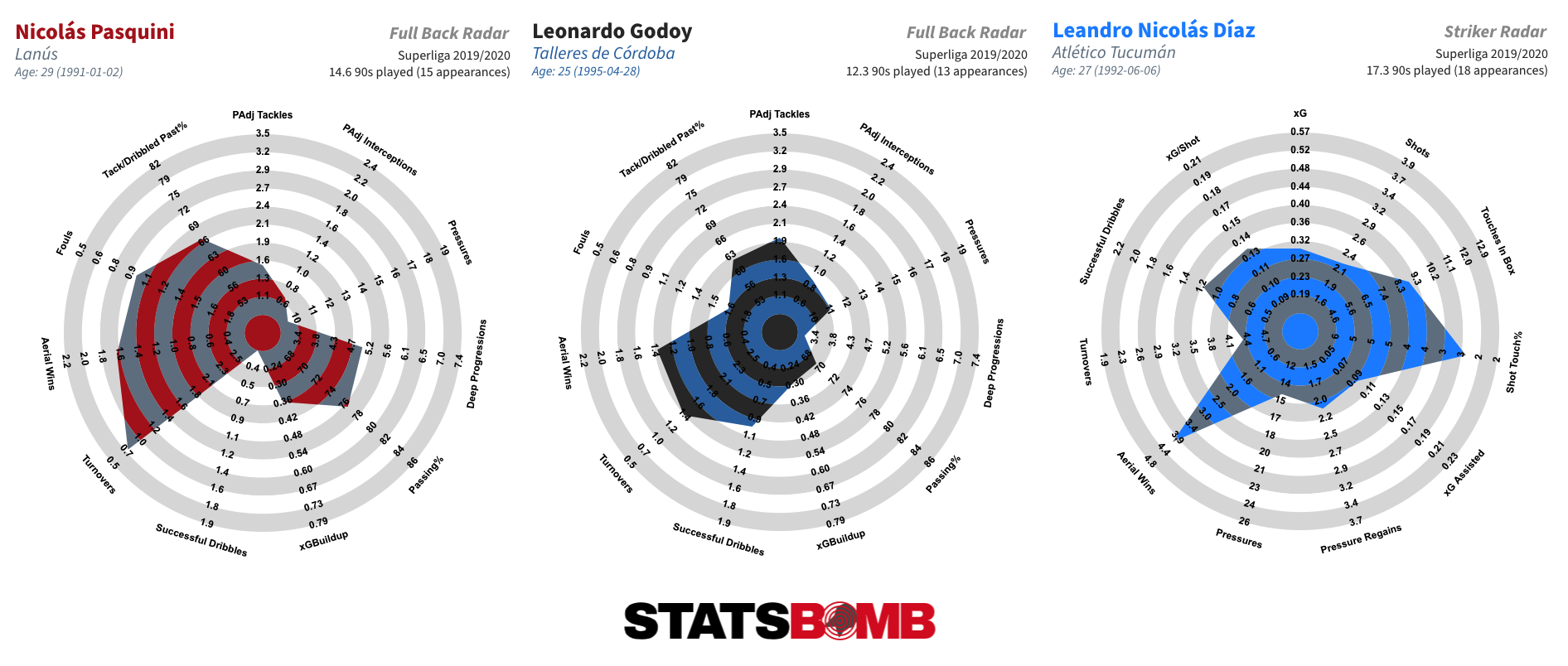 ND: Is there a particular signing you’re interested to see at their new club? VM: Maybe Edwin Cardona at Boca, to see how he fits into the team given that his characteristics, more suited to combination play, seem, in theory, pretty incompatible with Russo’s style of play. At San Lorenzo, it will be interesting to see how Franco Di Santo adapts to Argentinian football after spending his entire career outside the country. ND: In recent years, Di Santo has been a striker of few shots and few goals, so he shouldn’t be expected to score a lot. We’ll have to see what kind of role Soso has in mind for him.
ND: Is there a particular signing you’re interested to see at their new club? VM: Maybe Edwin Cardona at Boca, to see how he fits into the team given that his characteristics, more suited to combination play, seem, in theory, pretty incompatible with Russo’s style of play. At San Lorenzo, it will be interesting to see how Franco Di Santo adapts to Argentinian football after spending his entire career outside the country. ND: In recent years, Di Santo has been a striker of few shots and few goals, so he shouldn’t be expected to score a lot. We’ll have to see what kind of role Soso has in mind for him. 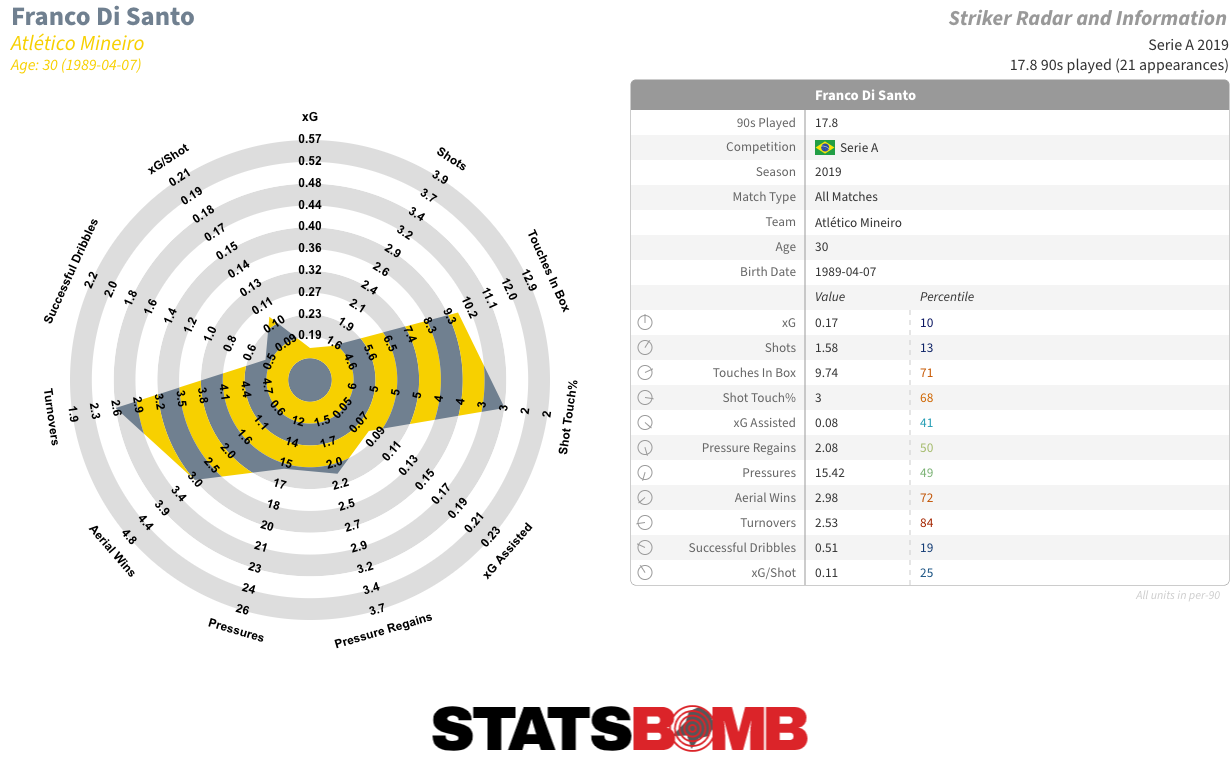 Who are the young players to keep tabs on? VM: At Racing, it will be interesting to see if Benjamin Garré, after showing promise at the back end of last season, is able to secure himself a starting berth and confirm what that run implied, namely that he is a skilled winger, incisive in one-on-one situations. It is obligatory to follow Thiago Almada. The Vélez player is ready to take a further step forward and become what he’s already hinted at becoming: a crack. He’s a skilled dribbler, incisive in one-on-ones, and with a good final pass. He is more than happy to take on the responsibility of generating advantageous positions for his team high up the pitch.
Who are the young players to keep tabs on? VM: At Racing, it will be interesting to see if Benjamin Garré, after showing promise at the back end of last season, is able to secure himself a starting berth and confirm what that run implied, namely that he is a skilled winger, incisive in one-on-one situations. It is obligatory to follow Thiago Almada. The Vélez player is ready to take a further step forward and become what he’s already hinted at becoming: a crack. He’s a skilled dribbler, incisive in one-on-ones, and with a good final pass. He is more than happy to take on the responsibility of generating advantageous positions for his team high up the pitch. 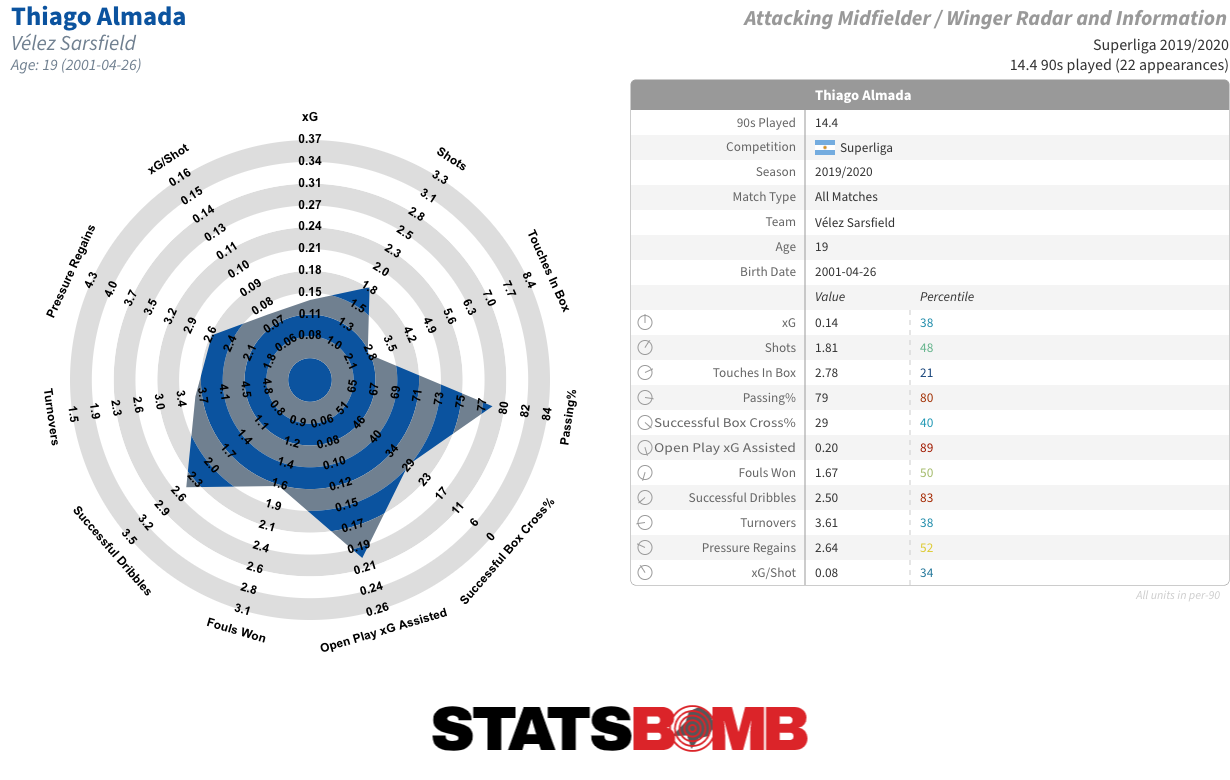 At Argentinos Juniors, Fausto Vera deserves a watch. The central midfielder of the Argentina Olympic team is technically sound, covers a lot of ground and reads play well, qualities that should allow him to establish himself as a great player for his club and also within the league. ND: With three goals and three assists in around 1,100 minutes of playing time, Tomás Badaloni of Godoy Cruz also looks like an interesting player to me. A goal or assist for every 180 minutes on the pitch is very good, particularly given that it runs in line with his expected output. We’ll see if he becomes a more regular starter in this tournament.
At Argentinos Juniors, Fausto Vera deserves a watch. The central midfielder of the Argentina Olympic team is technically sound, covers a lot of ground and reads play well, qualities that should allow him to establish himself as a great player for his club and also within the league. ND: With three goals and three assists in around 1,100 minutes of playing time, Tomás Badaloni of Godoy Cruz also looks like an interesting player to me. A goal or assist for every 180 minutes on the pitch is very good, particularly given that it runs in line with his expected output. We’ll see if he becomes a more regular starter in this tournament.  Great. Well, thanks again for your time Vicente. It's been a pleasure. VM: Thanks to you, Nick, and congratulations on the website. It provides very useful data with which to more deeply analyse the game.
Great. Well, thanks again for your time Vicente. It's been a pleasure. VM: Thanks to you, Nick, and congratulations on the website. It provides very useful data with which to more deeply analyse the game.
The Big 5 After 5: Premier League
We are five matchdays into a Premier League season that has already provided more than its fair share of incident and excitement. Here are some emerging trends. Goals, Goals, Goals Goals have been flying in from all angles, producing a series of seven-goal thrillers, five-goal thrashings and 3-3 draws that have enlivened the early running. With penalties included, there have been 3.58 goals per match. The total of 172 is 16 more than any other 48-game stretch in our data set (starting from the 2016-17 season). Will it continue? Probably not. Either through player adaptation or a more relaxed interpretation of the rules, the current rate of a penalty goal for every two matches is likely to eventually settle down to somewhere nearer the rate of one every three matches that is now pretty much standard across the major European leagues. It is also notable that non-penalty goals are running abnormally far ahead of expected goals (xG). The total of 147 is over 130% of the xG sum of 112.42. The furthest ahead that goals ran of xG in any consecutive 48-match sample last season was 111.35%. From 2016-17 onwards, the highest mark prior to the start of this season had been just over 120%. There are plenty of larger swings in smaller sample sizes, but in one of this size there has never previously been a swing of much over 20% at either end of the scale. All of which suggests that things will begin to slow down a bit as the campaign progresses. Is Anyone Good? It’s a fair question to ask. Liverpool and Manchester City were the clear pre-season favourites to occupy the top two positions, but both of them have already suffered heavy defeats -- City 2-5 at home to Leicester; Liverpool 2-7 away at Aston Villa. Manchester United have lost twice in four matches, including a 1-6 thrashing by Tottenham Hotspur; Chelsea are still just as open as they were last season and have carried a negative xG difference through their opening five fixtures. We could go on. Mikel Arteta has now had nearly a full season of matches on the Arsenal bench and while they do look more structurally sound to the eye, their numbers are still middling, and their shot volume is still poor. Leicester are fourth but have mediocre metrics. Only Aston Villa and Everton have traversed the opening weeks of the season undefeated. Spurs have very good metrics, but as with everything at this stage, it is too early to tell if that really means anything. Particularly so given that their numbers were so poor last season, and with the boost of that 6-1 win over United (3.07 to 0.16 on the non-penalty xG) to account for. West Ham have also looked good, as have Brighton by the numbers but less so by results. It will take at least another 5-10 matches for everything to shake out and give us a clearer idea of which teams are genuinely good and bad, maybe longer given the strange circumstances of the season. Once we get to that point it wouldn’t be at all surprising to see Liverpool and City again emerge as the league’s most impressive teams. Even with that Villa defeat on their record (a 3.91 to 1.77 defeat on xG), Liverpool have been so dominant in their other matches that they still have an overwhelming positive shot and xG difference. Their system is now arguably strong enough to absorb Virgil van Dijk’s absence, particularly once Alisson returns in goal. City’s attacking output hasn’t been great to date, but Pep Guardiola has done plenty of tinkering with the lineup and can be expected to eventually settle upon a workable formula. 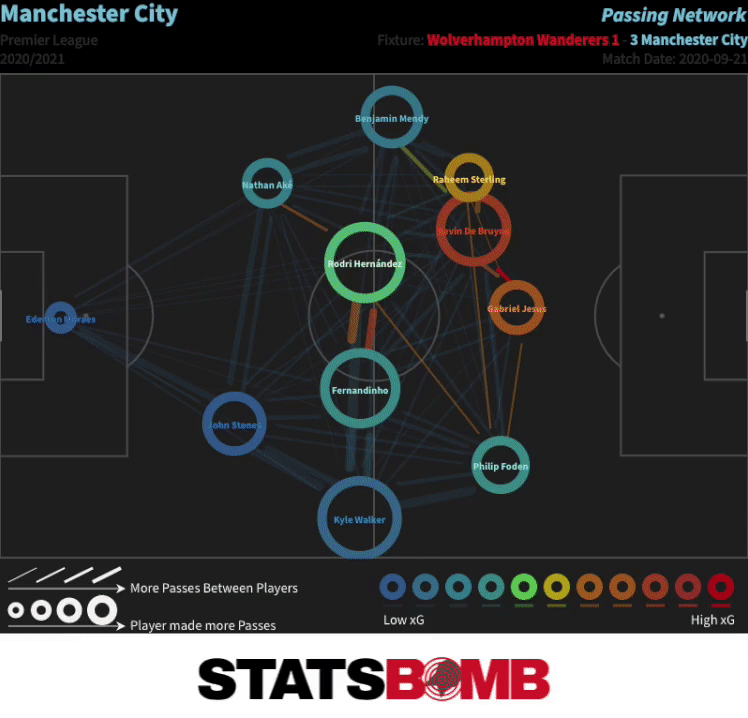 James Rodríguez Shines Everton’s purchase of James Rodríguez from Real Madrid was one of the more enticing off-season arrivals to the Premier League, and he has hit the ground running with three goals and three assists in five appearances. That is well ahead of his expected output, so he shouldn’t necessarily be expected to continue producing direct goal contributions at that rate, but even his underlying output has so far represented a clear improvement on the creative options Everton had last season. The sample size is very small, and so some variation should be expected over the course of the campaign, but on a per 90 basis, Rodríguez currently leads Everton in key passes (both from open play and set pieces), xG assisted and passes into the penalty area, in addition to also being the player who has most often moved the ball forward into the final third. All that while also getting off nearly 2.5 shots per 90. Reunited with Carlo Ancelotti, he has immediately become the team's attacking hub. Last season, no Everton player provided over two key passes per 90; Rodríguez has so far produced three. We certainly know a guy who’d relish the opportunity to work with a player capable of such quality deliveries from set pieces, particularly with a target like Yerry Mina on the other end of them.
James Rodríguez Shines Everton’s purchase of James Rodríguez from Real Madrid was one of the more enticing off-season arrivals to the Premier League, and he has hit the ground running with three goals and three assists in five appearances. That is well ahead of his expected output, so he shouldn’t necessarily be expected to continue producing direct goal contributions at that rate, but even his underlying output has so far represented a clear improvement on the creative options Everton had last season. The sample size is very small, and so some variation should be expected over the course of the campaign, but on a per 90 basis, Rodríguez currently leads Everton in key passes (both from open play and set pieces), xG assisted and passes into the penalty area, in addition to also being the player who has most often moved the ball forward into the final third. All that while also getting off nearly 2.5 shots per 90. Reunited with Carlo Ancelotti, he has immediately become the team's attacking hub. Last season, no Everton player provided over two key passes per 90; Rodríguez has so far produced three. We certainly know a guy who’d relish the opportunity to work with a player capable of such quality deliveries from set pieces, particularly with a target like Yerry Mina on the other end of them. 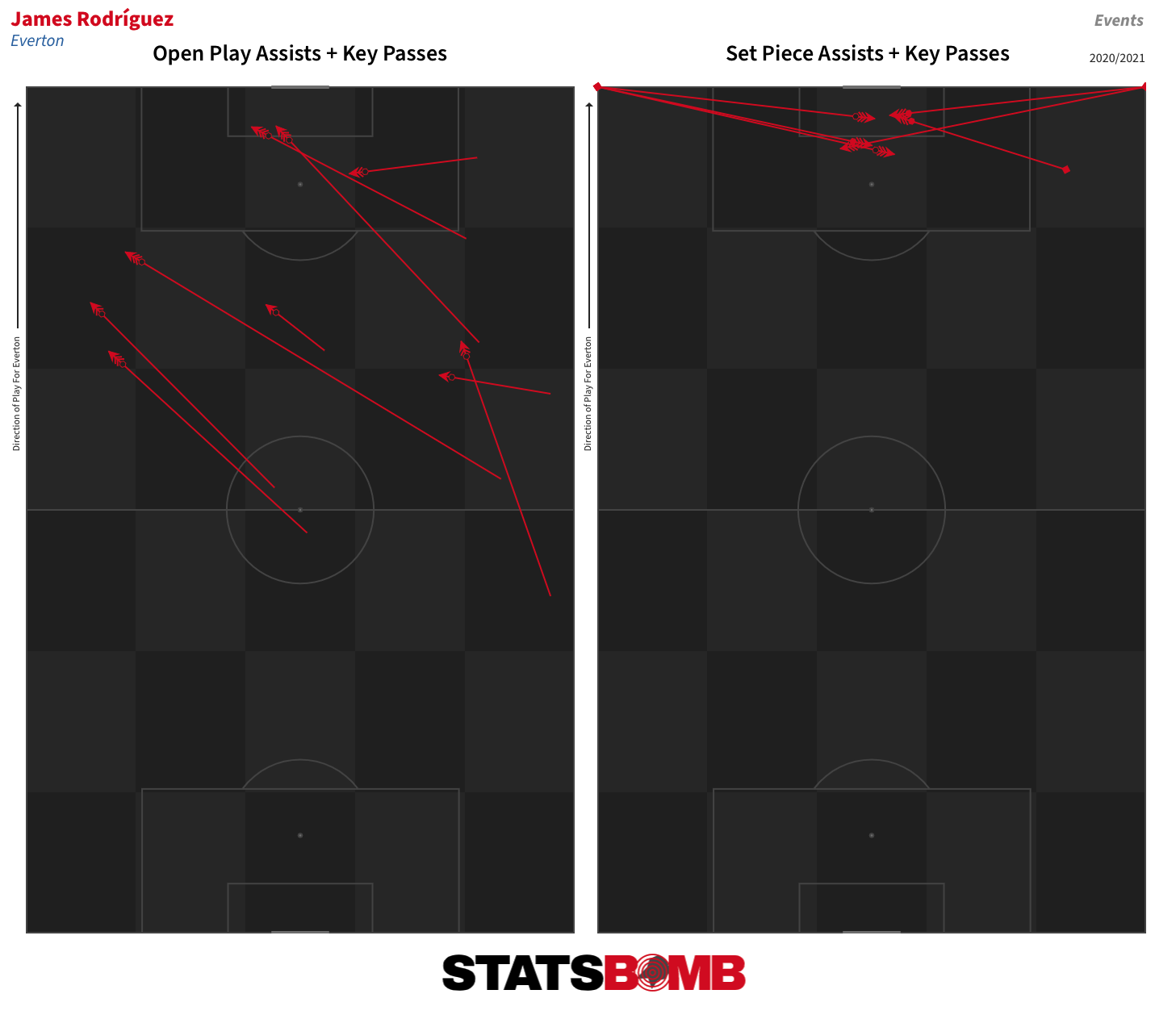 Everton have so far combined good results with very solid metrics, and that despite playing both Spurs and Liverpool across their opening five fixtures. As we've already said, we need a larger sample of matches before we can really start to draw any sort of meaningful conclusions on team quality, but Everton’s underlying numbers were better than results last season, and with Rodríguez on board, top eight should be their minimum aim.
Everton have so far combined good results with very solid metrics, and that despite playing both Spurs and Liverpool across their opening five fixtures. As we've already said, we need a larger sample of matches before we can really start to draw any sort of meaningful conclusions on team quality, but Everton’s underlying numbers were better than results last season, and with Rodríguez on board, top eight should be their minimum aim.
The Big 5 After 5: La Liga
We are five matchdays into the season in La Liga, so let’s have a look at some emerging trends from the early action. Spain Remains Light on Shots La Liga saw the least shots, goals and expected goals (xG) of any big five European league last season, and things have been even tighter in the early running of the new campaign. All three measures are down. While the English, Italian and German top flights have each averaged over three non-penalty goals per match, Spain has averaged just two, right in line with xG. There have been three less shots per match (20.30) than in any of the other leagues. Even in the context of a competition that remains steadfastly low on goalmouth action, Athletic Club stand out as a particularly bad watch. Their matches to date have barely averaged over a single expected goal and have featured the lowest shot count (15.25) of any in the league. A Promising Start for Betis Real Betis always looked like one of the prime candidates to move up the table this season. Their 15th place finish last time around was allied to top eight metrics, and the attacking talent within the squad is such that even a minor defensive improvement, whether through luck or judgement, was always going to make them top eight contenders. Nine points from their first five matches under Manuel Pellegrini represents a good start and has them second in the nascent table, albeit with at least two or three teams behind who will probably better their points haul once games in hand have been played. Even with defeats to Real Madrid and Getafe thrown into the mix, Betis have begun the campaign as a shot dominant team, outshooting their opponents in all of their matches and taking 64% of the total shots across those fixtures. It is a good starting point, but the difference between the quality of shots taken and conceded means they still have a negative expected goal difference at this stage. They are taking a few too many speculative efforts in attack... 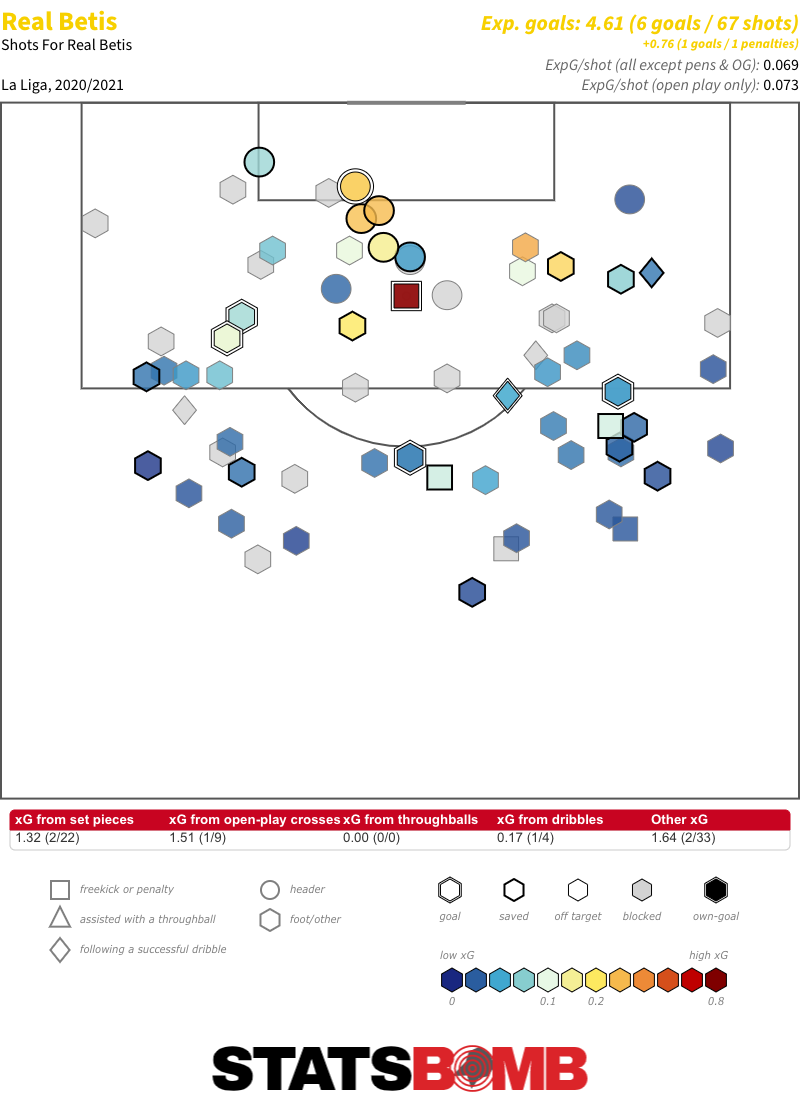 ...and while their higher defensive line and slightly more aggressive off-ball approach has so far done a solid job of suppressing opposition shot volume, the chances they have conceded have generally been high-quality ones.
...and while their higher defensive line and slightly more aggressive off-ball approach has so far done a solid job of suppressing opposition shot volume, the chances they have conceded have generally been high-quality ones. 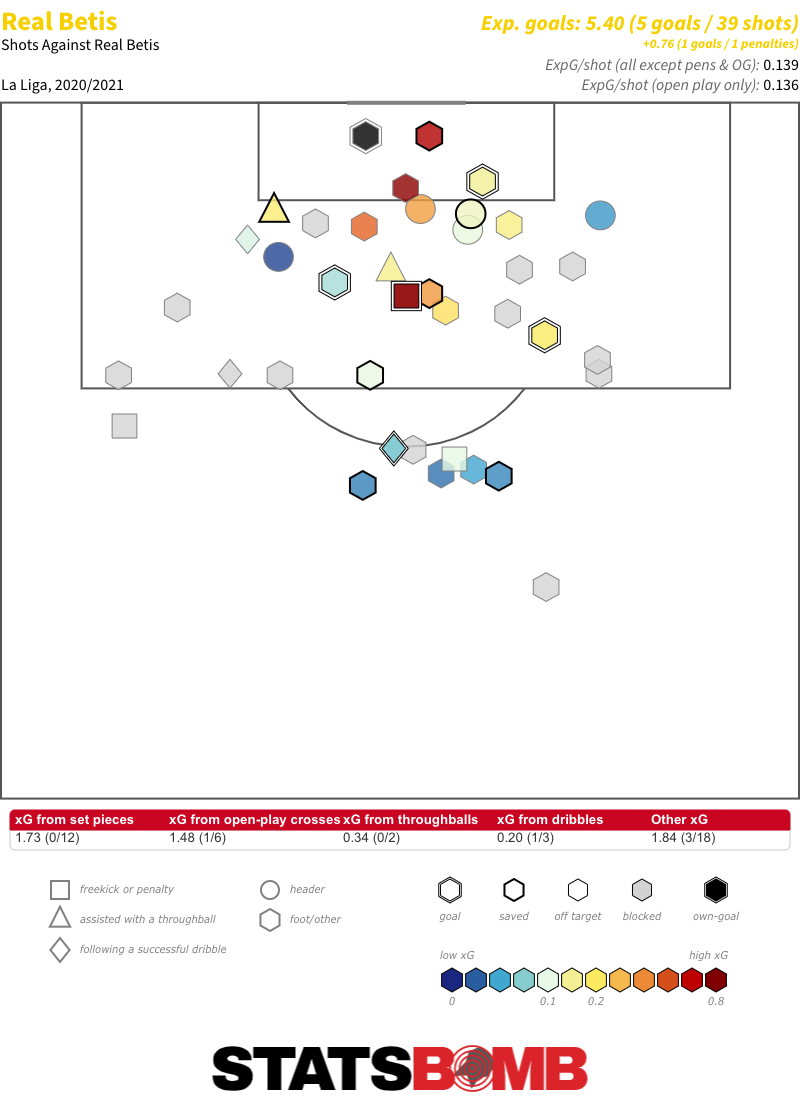 With that said, they have already played Real Madrid, which skews things in such a small sample size. It is also unlikely those shot quality numbers will hold throughout the campaign given that they would have been comfortably the worst in La Liga at both ends of the pitch last season. As things begin to equalise out a bit, we’ll have a better idea if Betis are genuine European contenders. Underpowered Elche Elche have only played three times to date, and do already have four points on the board, but they’ve looked decidedly underpowered on their return to the top flight following a five-year absence. Unsurprisingly so, given that they weren’t even a standout side in the Segunda División last season. They made it up through the playoffs after finishing sixth in the table with bottom six metrics. Add to that a new head coach and the ridiculously short period of time they had to prepare for the top flight due to the delayed promotion playoffs, and it is to be expected that they've looked out of their depth. Jorge Almirón’s side have averaged a pitiful four shots per match while conceding more than 18. They were outshot 27 to five by Real Sociedad in their opener, and then 18 to two by fellow newly promoted side Huesca in a 0-0 draw prior to the international break.
With that said, they have already played Real Madrid, which skews things in such a small sample size. It is also unlikely those shot quality numbers will hold throughout the campaign given that they would have been comfortably the worst in La Liga at both ends of the pitch last season. As things begin to equalise out a bit, we’ll have a better idea if Betis are genuine European contenders. Underpowered Elche Elche have only played three times to date, and do already have four points on the board, but they’ve looked decidedly underpowered on their return to the top flight following a five-year absence. Unsurprisingly so, given that they weren’t even a standout side in the Segunda División last season. They made it up through the playoffs after finishing sixth in the table with bottom six metrics. Add to that a new head coach and the ridiculously short period of time they had to prepare for the top flight due to the delayed promotion playoffs, and it is to be expected that they've looked out of their depth. Jorge Almirón’s side have averaged a pitiful four shots per match while conceding more than 18. They were outshot 27 to five by Real Sociedad in their opener, and then 18 to two by fellow newly promoted side Huesca in a 0-0 draw prior to the international break. 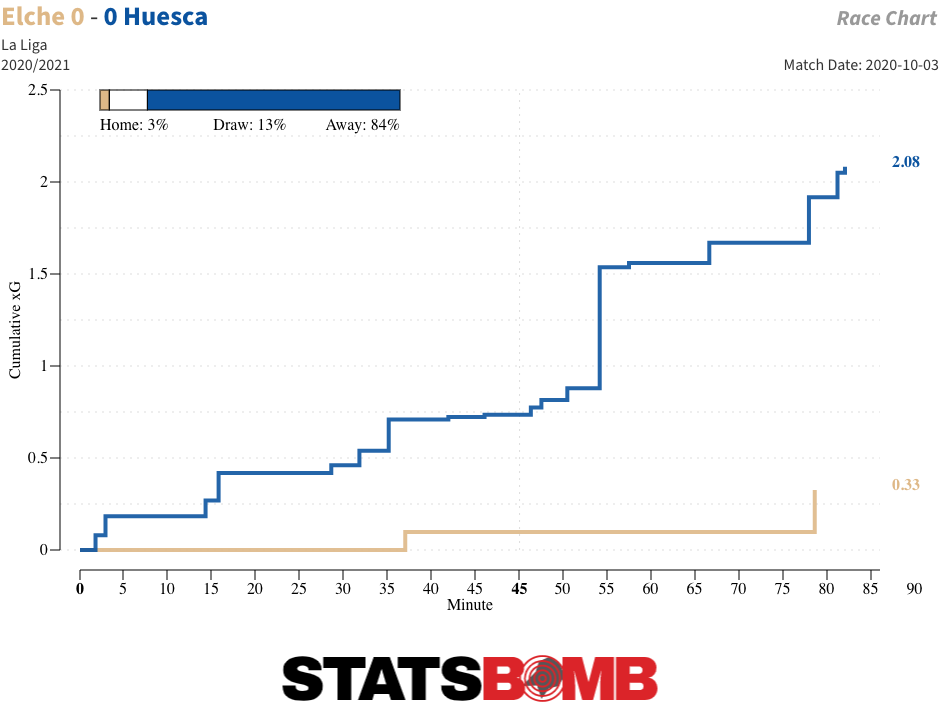 The squad has been reinforced with a flurry of late deals, no one can take the points they’ve already got away from them, and their shot numbers will naturally smooth out a little over time. But performances will have to improve massively if Elche are to have any chance of remaining in the division. New Arrivals Doing Their Thing David Silva may only have started three of Real Sociedad’s five matches to date, but he still leads the league in total open play passes into the penalty area. On a per-90 basis, he ranked in the top four of the Premier League in that metric for Manchester City in each of the last four seasons, and it seems he will again be amongst the most prolific suppliers in La Liga.
The squad has been reinforced with a flurry of late deals, no one can take the points they’ve already got away from them, and their shot numbers will naturally smooth out a little over time. But performances will have to improve massively if Elche are to have any chance of remaining in the division. New Arrivals Doing Their Thing David Silva may only have started three of Real Sociedad’s five matches to date, but he still leads the league in total open play passes into the penalty area. On a per-90 basis, he ranked in the top four of the Premier League in that metric for Manchester City in each of the last four seasons, and it seems he will again be amongst the most prolific suppliers in La Liga. 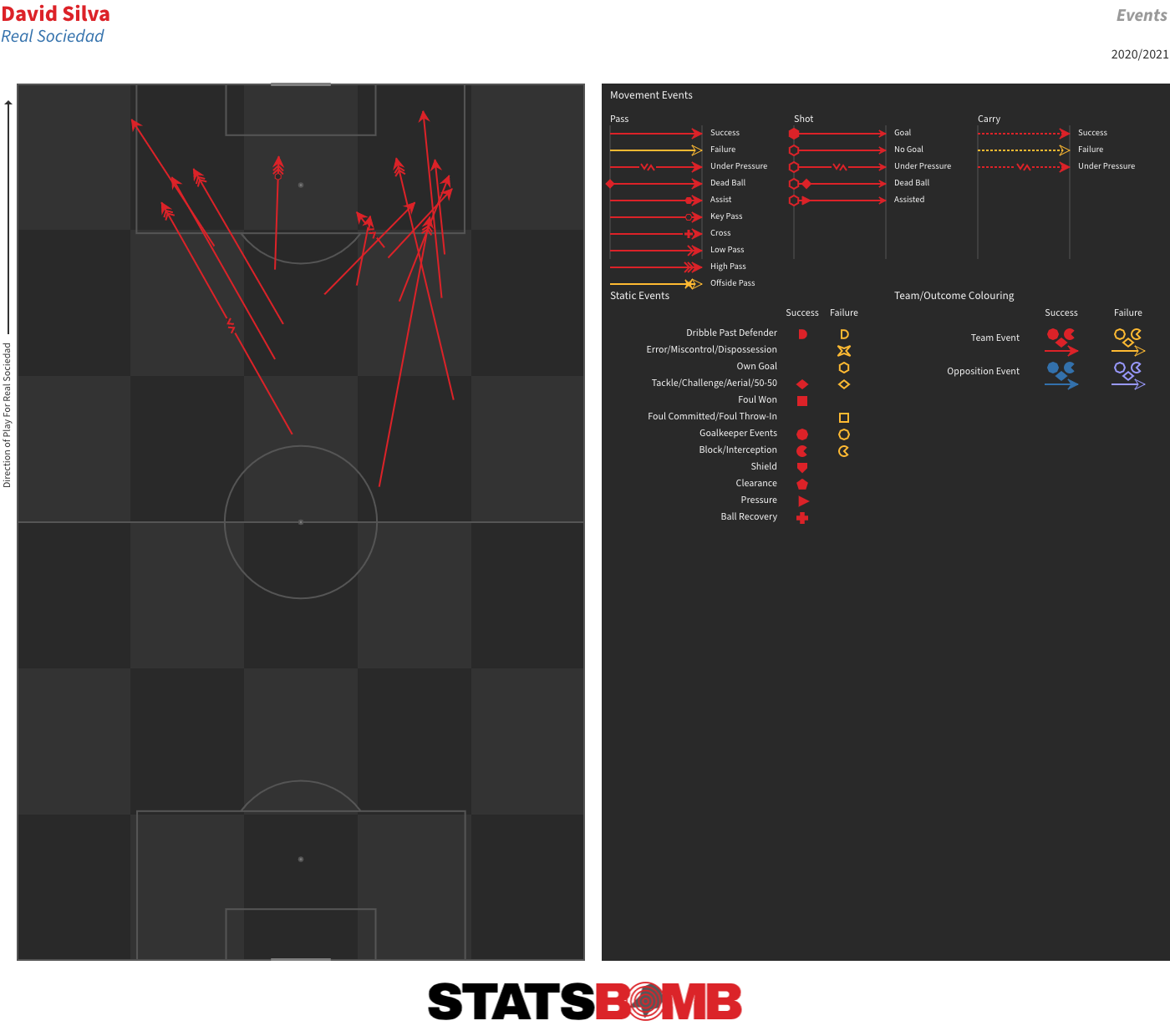 Dani Parejo may not have any goals or assists to his name since his off-season move from Valencia to Villarreal, but he’s continued to be the same reliable ball progresser as always.
Dani Parejo may not have any goals or assists to his name since his off-season move from Valencia to Villarreal, but he’s continued to be the same reliable ball progresser as always. 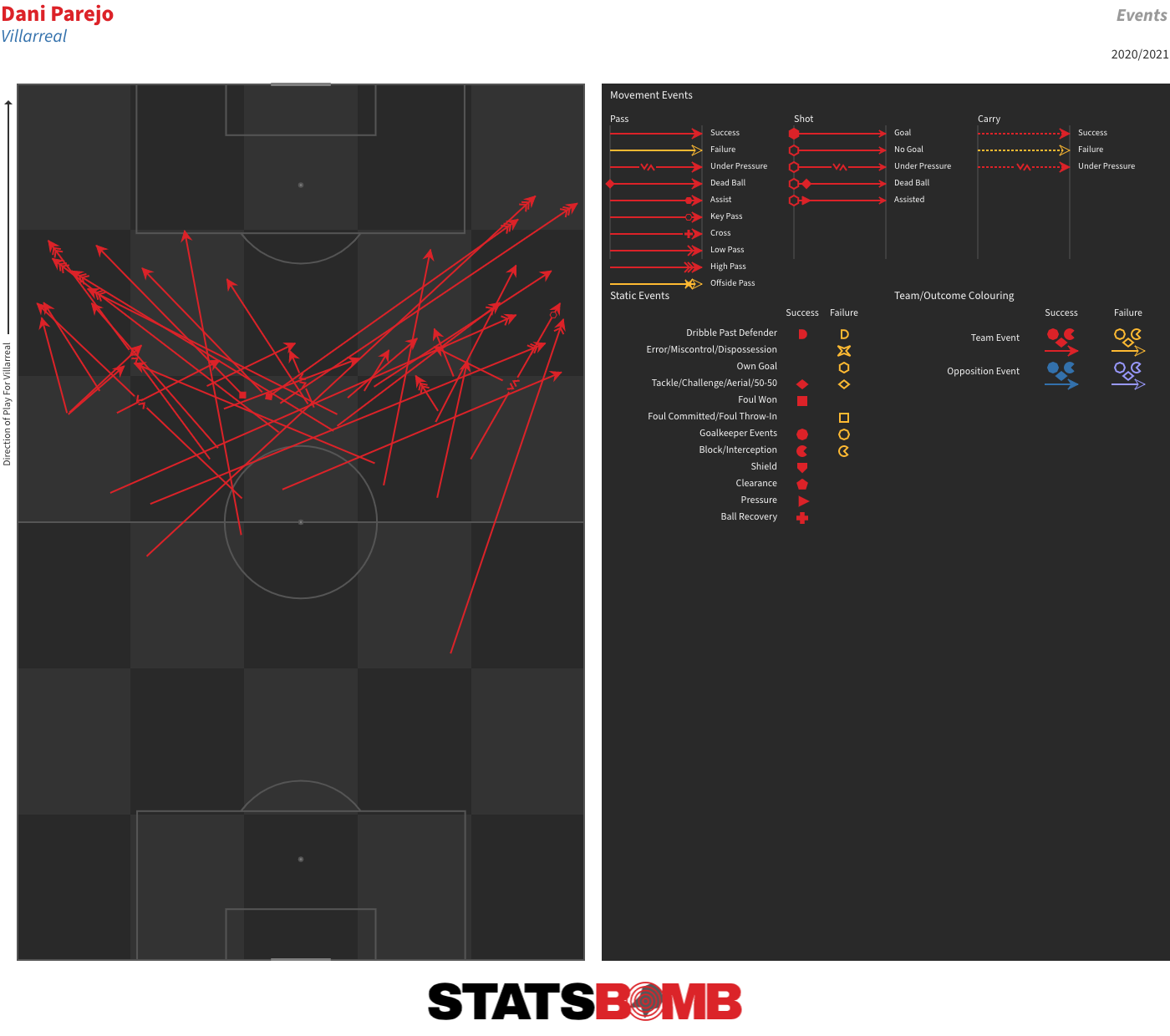 Emre Mor is back at Celta Vigo, and even if he hasn't done much else, he continues to be a prolific dribbler.
Emre Mor is back at Celta Vigo, and even if he hasn't done much else, he continues to be a prolific dribbler. 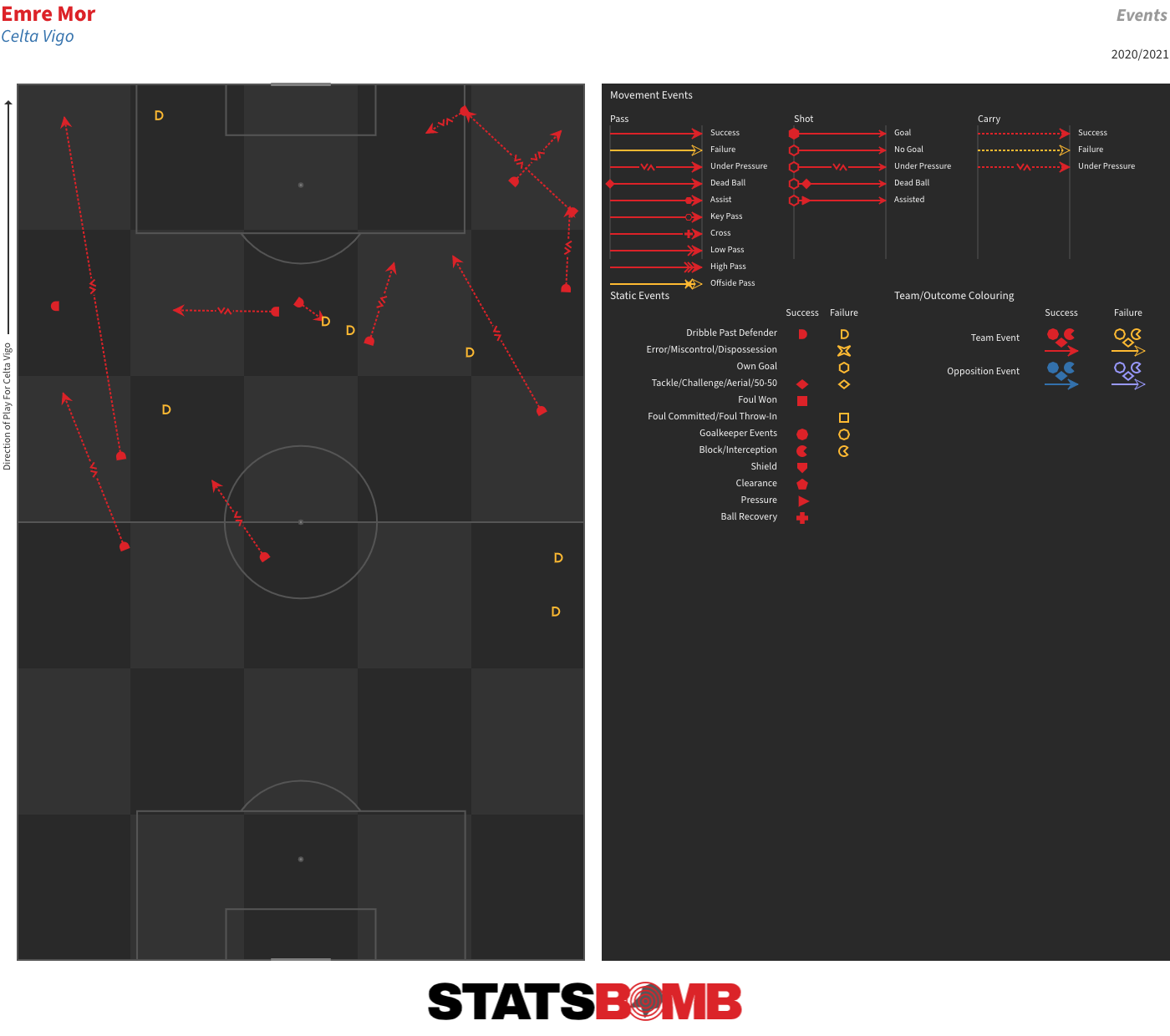 And Javi Ontiveros may have only seen a combined 90 minutes or so of action for Huesca after joining on loan from Villarreal, but the player who last season took more shots per 90 amongst players who saw at least 900 minutes of action than anyone but Lionel Messi has already got off four efforts on goal -- just below his 2019-20 average.
And Javi Ontiveros may have only seen a combined 90 minutes or so of action for Huesca after joining on loan from Villarreal, but the player who last season took more shots per 90 amongst players who saw at least 900 minutes of action than anyone but Lionel Messi has already got off four efforts on goal -- just below his 2019-20 average. 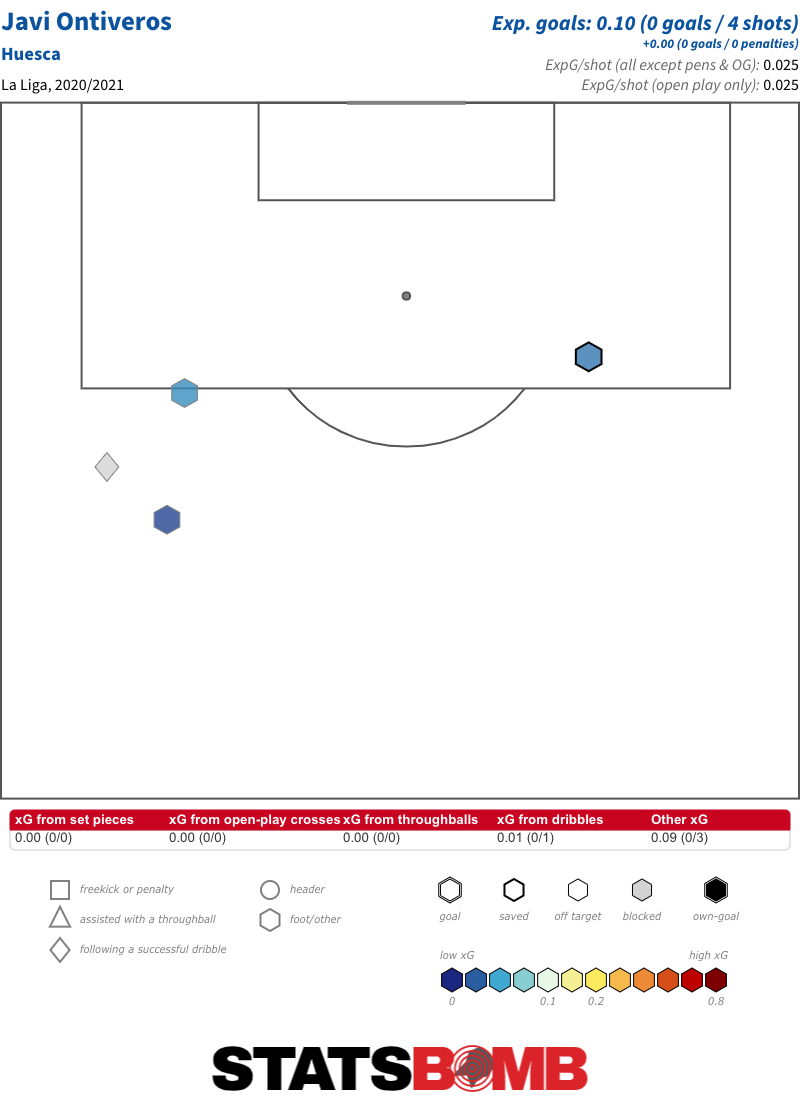
The Big 5 After 5: Ligue 1
Ligue 1 was the first of the big five European leagues to get its 2020-21 season underway. Five matchdays in, let’s look at four interesting things from the early running in France. Rennes Lead The Way Rennes are the early leaders after taking four wins and a draw from their opening set of fixtures. Their underlying numbers also look promising, continuing the trend from the second half of last season’s abruptly shortened championship, when they had the second best metrics in the division behind Paris Saint-Germain. Then, a switch to a more proactive defensive approach, albeit still a pretty average one in the overall context of the league, yielded dividends at both ends of the pitch. Rennes began to create a higher number of better quality shots whilst conceding a lower number of worse quality ones. They became much more adept at creating opportunities in transitional phases of play, and leaned less on crosses as a means of entering the penalty area. 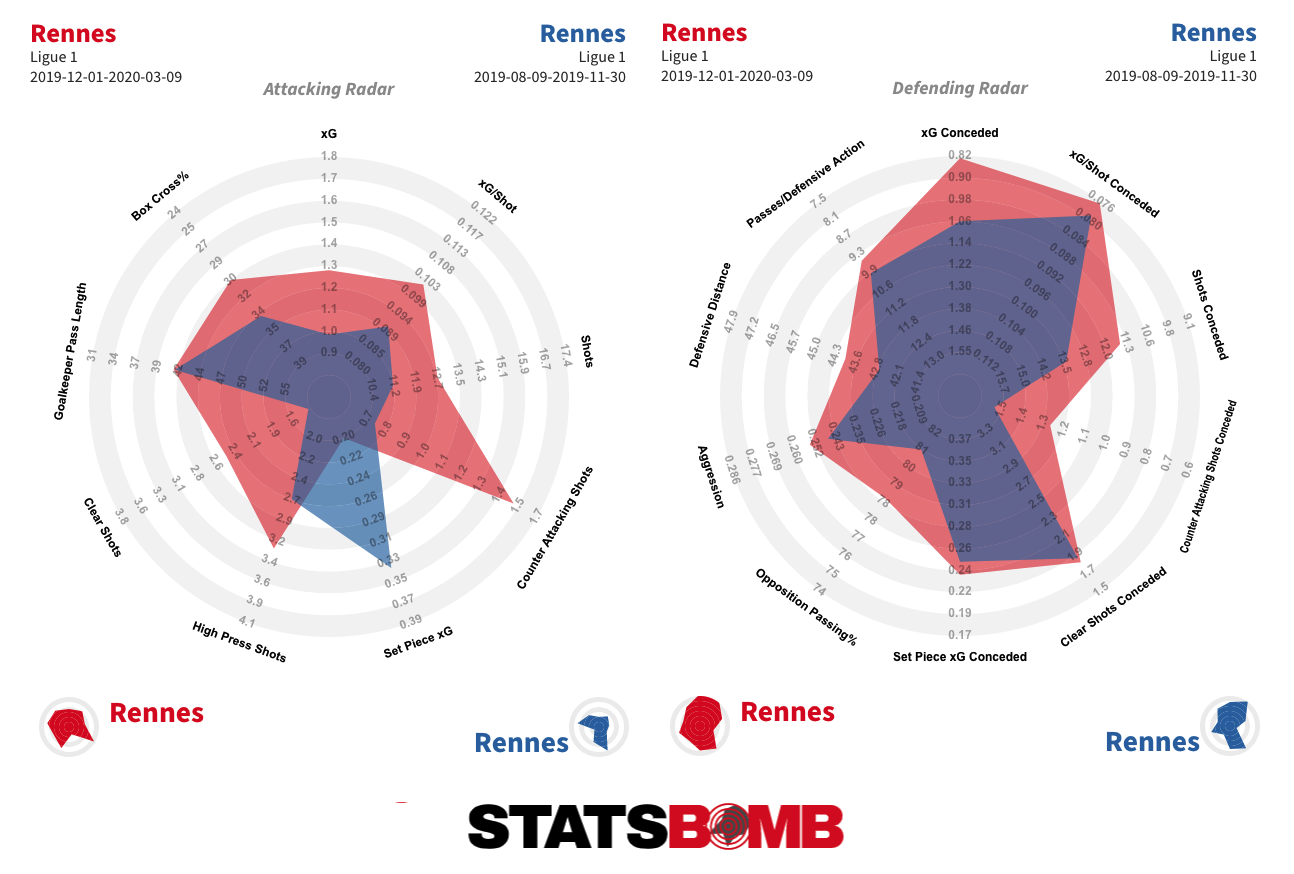 Those same broad stylistic traits seem to have carried into the early running of 2020-21, and their position atop the table is reflective of a smart club seemingly on the up. They won the Coupe de France in 2018-19, and last season’s third-place finish means that this time around they will compete in the Champions League for the first time in their history. Paris Saint-Germain: Still Good Paris Saint-Germain started the season poorly with consecutive 1-0 defeats to Lens and Marseille, a pair of results that predictably produced rumblings over the future of head coach Thomas Tuchel and talks of potential dressing room unrest. They’ve since recorded three straight wins without conceding, and their metrics suggest all is well. PSG have taken 66% of the shots in their matches and accumulated nearly 73% of the expected goals. They were genuinely bad against Lens in their opener, mainly because they were missing a bunch of key players including Ángel Di Maria, Kylian Mbappé, Marquinhos and Neymar, but they’ve otherwise been their normal dominant selves. As much as everyone would love to see a tighter title race, there is scant evidence of any kind of downturn or easing on their part. Even if a team like Lille, Lyon, Marseille, Monaco or Rennes does improve significantly, PSG were so insanely far ahead of the rest last season that even a slight easing in their output would still likely make them comfortable champions. A Great Start for Lens Newly promoted Lens have so far not looked at all out of place in the top flight. Three wins and a draw from their first five fixtures have them up in the top six, and their metrics look even better. They’ve taken a 63% share of the shots in their matches, and have carried an xG difference of +6.43 through these early weeks of the campaign, second only to PSG. Realistically, they aren’t going to maintain those numbers through the entire season, but it is a great start, and there is much to like in their approach. The new arrivals also seem to be producing. Gaël Kakuta is enjoying himself as one of two attacking midfielders in their 3-4-2-1 system, while Ignatius Ganago already has four goals (from 3.75 xG) on the board. Facundo Medina has replicated the bold ball-carrying and impressive passing range that saw him stand out at Talleres de Córdoba last season.
Those same broad stylistic traits seem to have carried into the early running of 2020-21, and their position atop the table is reflective of a smart club seemingly on the up. They won the Coupe de France in 2018-19, and last season’s third-place finish means that this time around they will compete in the Champions League for the first time in their history. Paris Saint-Germain: Still Good Paris Saint-Germain started the season poorly with consecutive 1-0 defeats to Lens and Marseille, a pair of results that predictably produced rumblings over the future of head coach Thomas Tuchel and talks of potential dressing room unrest. They’ve since recorded three straight wins without conceding, and their metrics suggest all is well. PSG have taken 66% of the shots in their matches and accumulated nearly 73% of the expected goals. They were genuinely bad against Lens in their opener, mainly because they were missing a bunch of key players including Ángel Di Maria, Kylian Mbappé, Marquinhos and Neymar, but they’ve otherwise been their normal dominant selves. As much as everyone would love to see a tighter title race, there is scant evidence of any kind of downturn or easing on their part. Even if a team like Lille, Lyon, Marseille, Monaco or Rennes does improve significantly, PSG were so insanely far ahead of the rest last season that even a slight easing in their output would still likely make them comfortable champions. A Great Start for Lens Newly promoted Lens have so far not looked at all out of place in the top flight. Three wins and a draw from their first five fixtures have them up in the top six, and their metrics look even better. They’ve taken a 63% share of the shots in their matches, and have carried an xG difference of +6.43 through these early weeks of the campaign, second only to PSG. Realistically, they aren’t going to maintain those numbers through the entire season, but it is a great start, and there is much to like in their approach. The new arrivals also seem to be producing. Gaël Kakuta is enjoying himself as one of two attacking midfielders in their 3-4-2-1 system, while Ignatius Ganago already has four goals (from 3.75 xG) on the board. Facundo Medina has replicated the bold ball-carrying and impressive passing range that saw him stand out at Talleres de Córdoba last season. 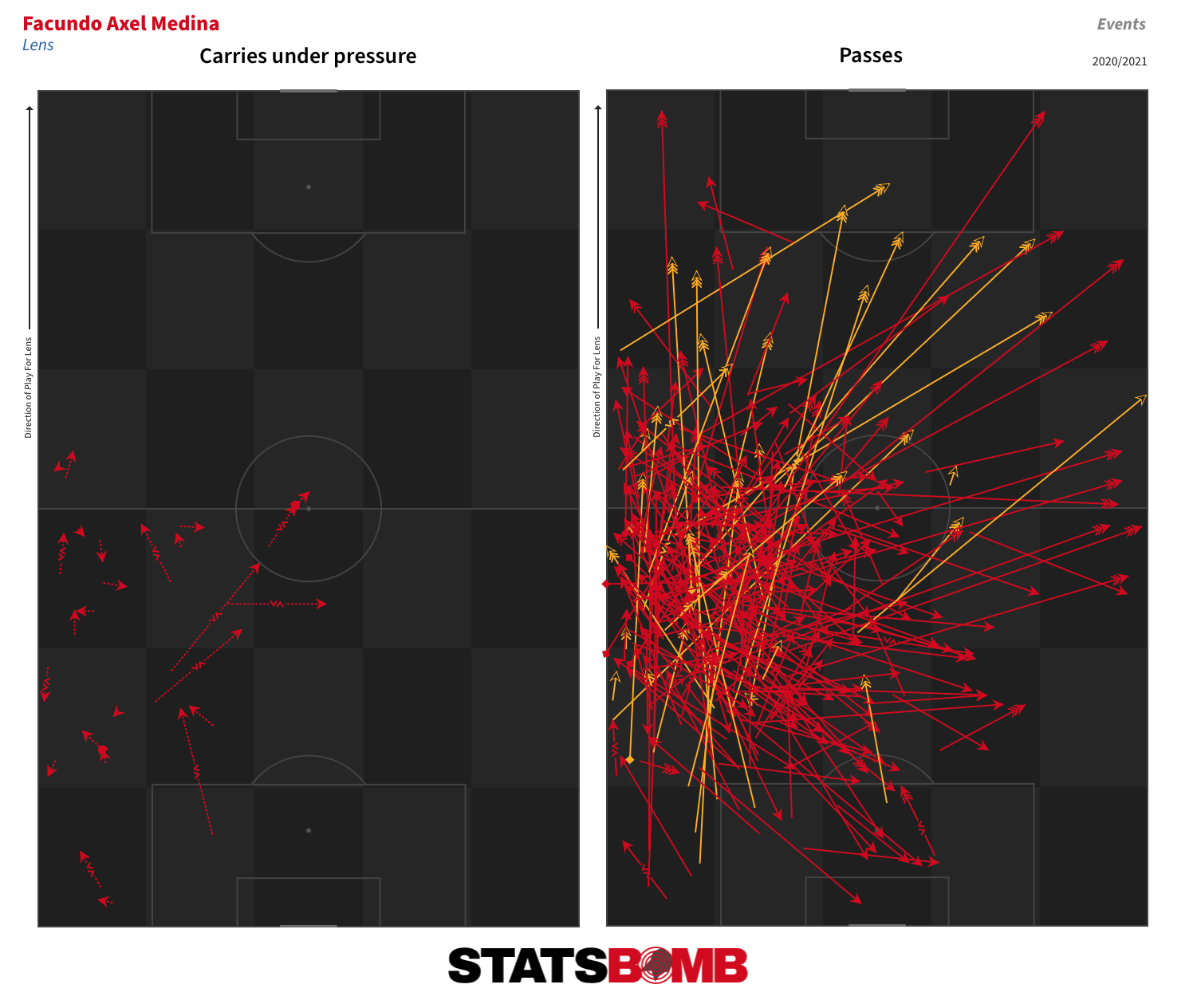 The underlying numbers also suggest that Lorient, who came up ahead of Lens as Ligue 2 champions, have been better than results to date might indicate. The two promoted teams have avoided a direct return to the second tier in each of the last two Ligue 1 seasons. That run might just continue through 2020-21. Bamba Finally Gets His Goal After 12 non-penalty goals in 2018-19, Lille’s Jonathan Bamba failed to register a single goal from 44 shots last season -- the highest non-scoring tally in the league.
The underlying numbers also suggest that Lorient, who came up ahead of Lens as Ligue 2 champions, have been better than results to date might indicate. The two promoted teams have avoided a direct return to the second tier in each of the last two Ligue 1 seasons. That run might just continue through 2020-21. Bamba Finally Gets His Goal After 12 non-penalty goals in 2018-19, Lille’s Jonathan Bamba failed to register a single goal from 44 shots last season -- the highest non-scoring tally in the league. 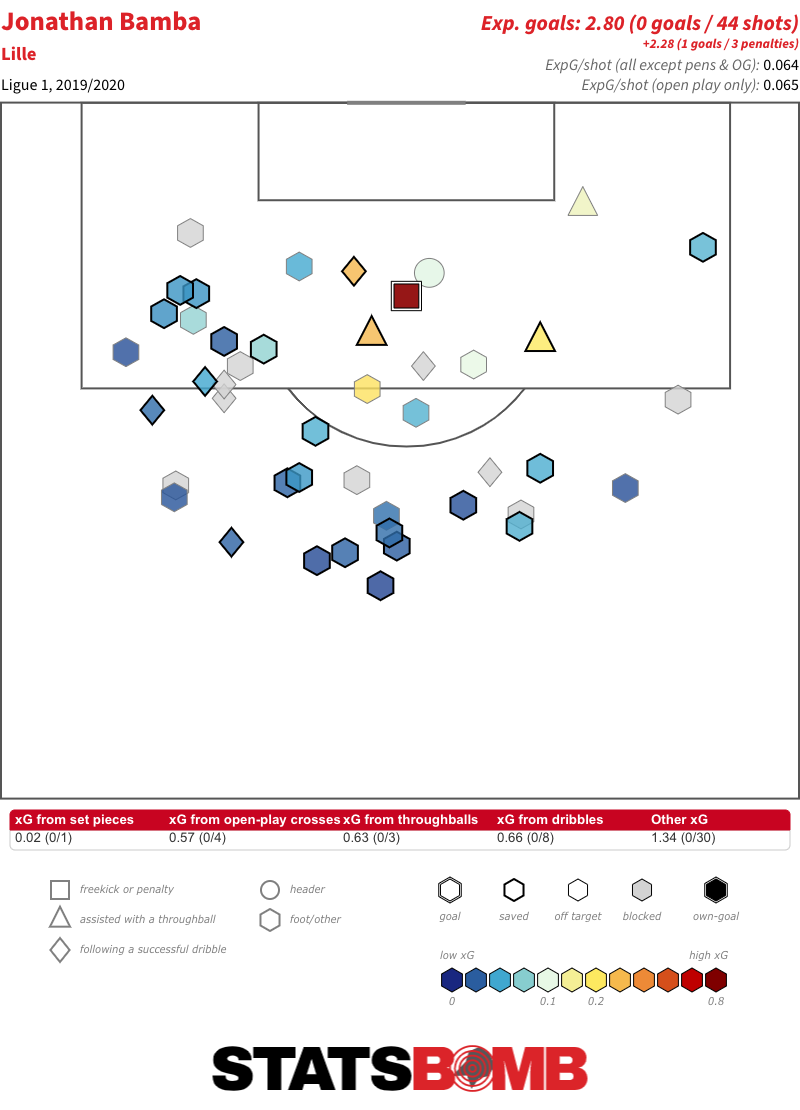 There was a bit of finishing variance involved there, but there was also a notable decline in the value of his shot locations in a post-Nicolas-Pépé world. The average quality reduced from 0.11 xG/shot in 2018-19 down to 0.06 xG/shot in 2019-20. But things seem to be looking up for Bamba this time around. He scored with his first shot of the new campaign in the opening day draw against Rennes, and added another in the 1-0 win away at Reims that followed it.
There was a bit of finishing variance involved there, but there was also a notable decline in the value of his shot locations in a post-Nicolas-Pépé world. The average quality reduced from 0.11 xG/shot in 2018-19 down to 0.06 xG/shot in 2019-20. But things seem to be looking up for Bamba this time around. He scored with his first shot of the new campaign in the opening day draw against Rennes, and added another in the 1-0 win away at Reims that followed it. 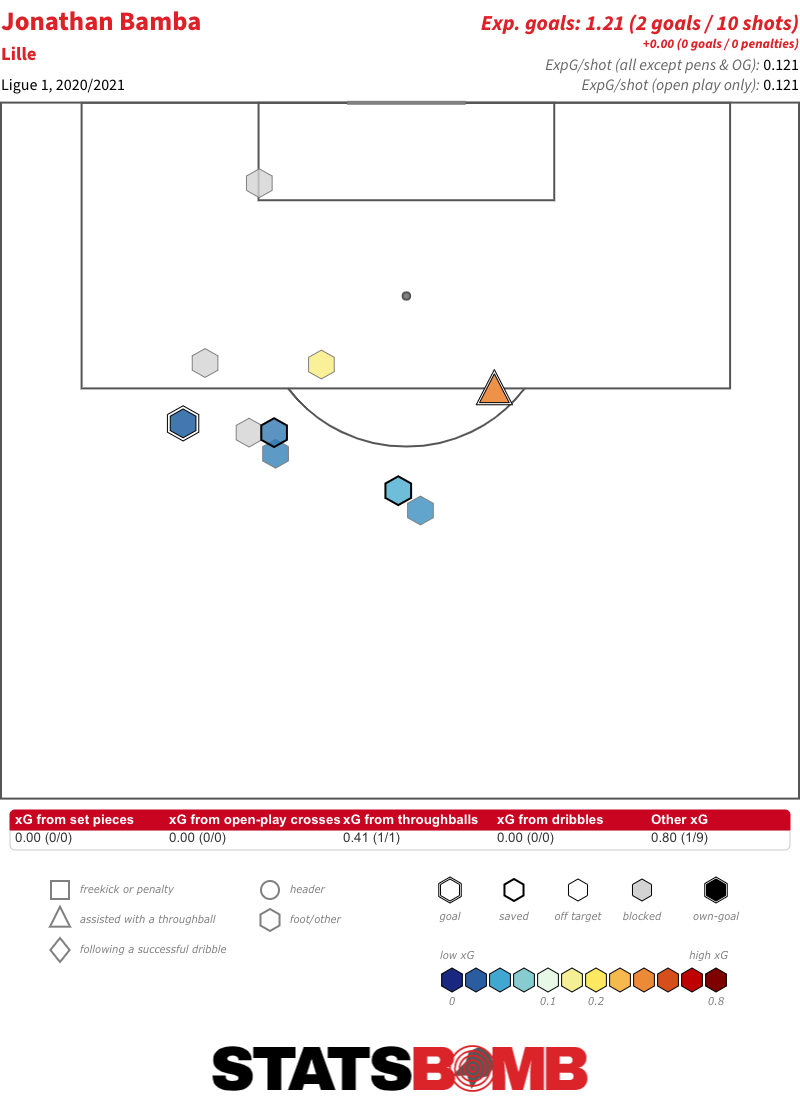 Lille have rebuilt their attack again this year following the big-money departure of Victor Osimhen to Napoli, and the changes seem to be to Bamba’s liking. The sample size is way too low to extrapolate too much from it, but the early signs are promising for a return to his output of two seasons past.
Lille have rebuilt their attack again this year following the big-money departure of Victor Osimhen to Napoli, and the changes seem to be to Bamba’s liking. The sample size is way too low to extrapolate too much from it, but the early signs are promising for a return to his output of two seasons past.
